












Bus Stop Sales is delighted to present the latest addition to its already extensive (Australia’s largest) range of electric bus solutions.

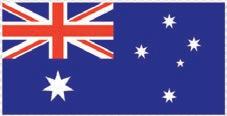

Bus Stop hand selected the best component available globally to assemble the best overall package for Australian operators. The simple and more traditional drivetrain combined with the superior body / chassis build quality means the Bus Stop EVolution is a must inspect for savvy operators looking for world class value. Incredibly best in class, genuine components such as the following are included as standard:


It’s no secret that Australia’s bus and coach industry is exceptionally good at leading trends and finding innovative ways to carry on. Nothing attests to this more than the April edition of ABC magazine, which combines the latest innovations in vehicle and telematics technology with sales statistics that prove the industry’s ability to overcome issues.
Looking at other industries, we’re seeing unprecedented numbers of major companies crashing and burning due to a variety of reasons, not least the slow burn of inflated diesel prices and the continual impact that the COVID-19 pandemic is having on supply chains both in and out of Australia.
It’s in these challenging times that the bus and coach industry has proven its adaptability.
Instead of suffering similar fates across the board, the sector’s capacity to rely on itself to innovate in the vehicle, parts and technology markets has meant that supply chain and inflation issues are mainly only a hinderance, not a killer, of business, except for a few sad stories in the industry recently.
This is proved in many ways, starting with a record number of deliveries in March.
There appears to be no lag in the number of buses and coaches being delivered to customers in Australia, with
impacted supply chains. It’s a credit to the whole industry that companies have been able to meet increasing work demands with all of the challenges facing the sector.
It’s taken novel approaches to bus and coach manufacturing to keep the Australian industry mobile and afloat. Nothing summarises this willingness to innovate locally better than our cover story on ARCC.
ARCC’s designs for the future of zero-emissions bus manufacturing are special in an industry where using resources and sustainable materials can cost so much. ARCC managing director Peter Murley chats with ABC from page 24 about the minimalist way ARCC is planning for a versatile zero-emissions future.
Yet forward thinking isn’t just limited to vehicle manufacturing in the bus and coach industry. Our telematics feature looks at two unique companies who are excelling in different ways. From page 36, Consat Telematics, a well-known provider of many different fleet management and communication systems, sheds some light on its new Fleet Studio web
application and the surprising benefits it is having on bus operations.
On page 40, Connect Source has taken a different approach and ventured into the telematics game. By combining solutions from telematics providers and electric vehicle charging companies, Connect Source has put forth a revolutionary complete package for Australian electric bus owners.


In our latest round of operator stories, the sale of Coolum Coaches by industry veteran Glynn Ross to Thompsons
Bus Services is a feel-good tale of family-owned operators still prevailing (page 29), while Victorian bus driver Jeff O’Meara walked us through his incredible school bus driving career from page 33.
Yutong continues to go from strength to strength, with its new VDI Australia premises in Perth set to cover it in more glory in Western Australia on page 45, while Scania is introducing its new Touring coach model into Australia on page 48 and Projecta is finding ways to increase its inverter’s power capabilities.
While the industry flourishes in many ways, there are still plenty of different issues to cover.
These were discussed at length at last month’s Bus Industry Confederation (BIC) Summit in Canberra, where skilled worker attraction and retention was a hot topic, along with the infrastructure challenges associated with the zero-emissions transition.
The conference, along with the assortment of stories in this busy April edition, prove that the bus and coach industry is on the right path to emerge out the other side of the supply chain challenges not only intact, but better than ever.
The supply chain issue hangover is still continuing to wreak havoc in many Australian industries, but March’s deliveries show someone forgot to tell the bus and coach sector.
“It’s in these challenging times that the bus and coach industry has proven its adaptability.”
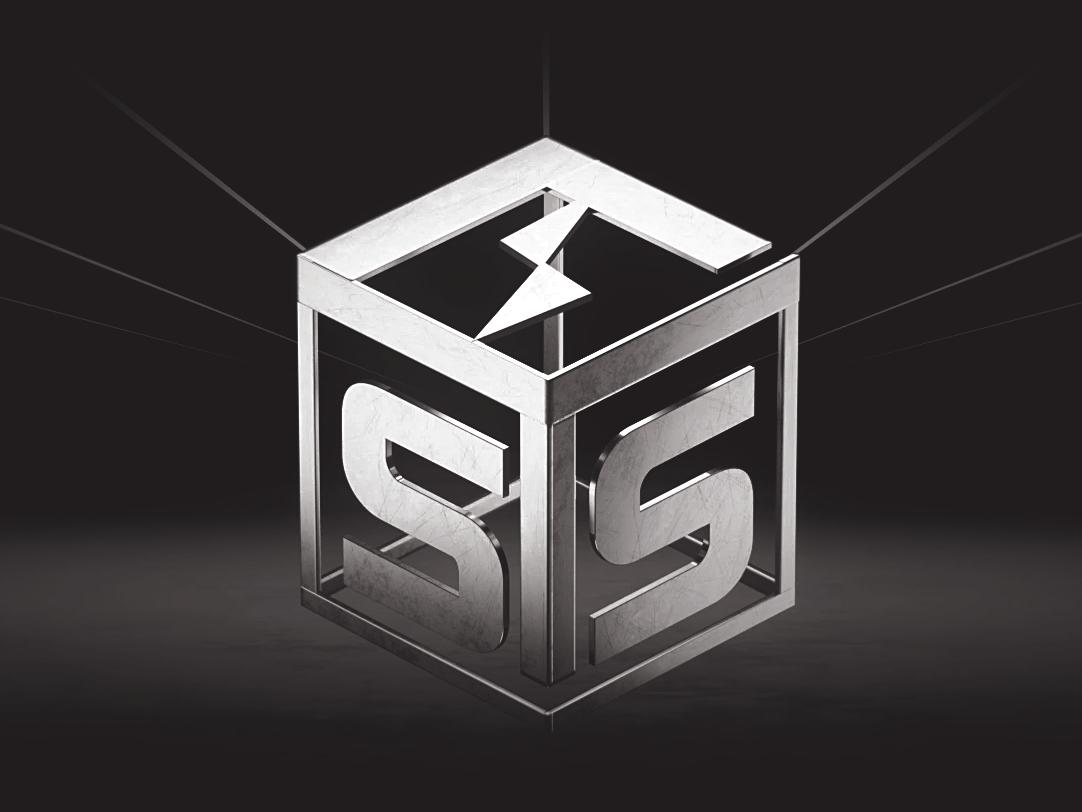
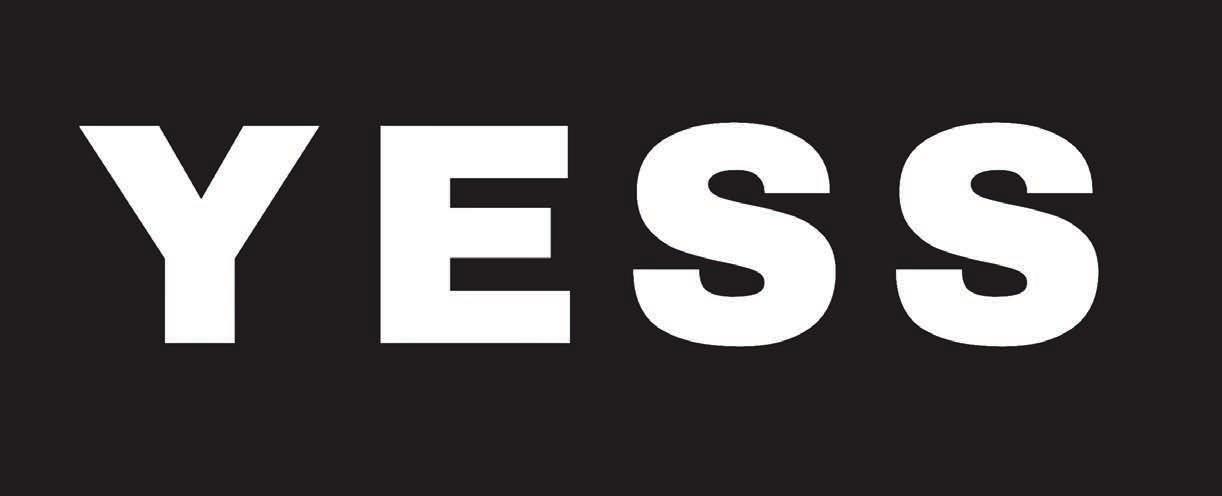













Facebook – facebook.com/ABCBusnews YouTube – bit.ly/busandcoachtv Twitter – twitter.com/ABCmag
6. editorial | building momentum
The supply chain issue hangover is still continuing to wreak havoc in many Australian industries, but March’s deliveries show someone forgot to tell the bus and coach sector.
10. news | all aboard
An overview of the latest Australasian and international bus and coach news that you need to know.
17. bic column
MAKING CHANGES
The BIC is set to announce numerous new decisions regarding the future of the Australian bus and coach industry.
18. cover story | arcc
FACES OF CHANGE
In just its seventh year as a company, technology and manufacturing brand ARCC is continuing to accelerate its future thinking when it comes to redesigning the way a zero-emissions bus should be built.
23. operator | coolum coaches
KEEPING IT COOLUM
Even when diverted, Glynn Ross’s life has never strayed far from the bus industry. It made it incredibly difficult for him to decide to sell Coolum Coaches to another family-based operator.
27. operator | jeff o’meara
SCHOOL BUS DEDICATION
When Jeff O’Meara first started hopping on school buses as a kid, he never wanted to follow in the footsteps of the driver. But chance circumstances meant he was drawn into a rewarding career in the bus industry.
30. telematics feature | consat telematics
A SWISS ARMY KNIFE
Consat Telematics’s development of smart systems for public transport is being put together on Consat’s new diverse web application.
34. telematics feature | connect source
MATCH MADE IN HEAVEN
Connect Source has quickly built upon its strong foundations as an electric component manufacturer. Now, it’s combining telematics with cutting-edge electric vehicle charging technology to provide a unique combination to Australian operators.

38. column | busnsw HEADING FOR THE GONG
BusNSW has announced that its annual 2023 Member Conference is set to be held in beautiful Wollongong.
39. column | busvic PLANNING AHEAD
After last year’s BusNSW Expo in Sydney drew mammoth crowds back to the bus and coach exhibition, BusVic will follow suit next year.
41. feature | yutong PRIORITISING PERTH
VDI Australia’s emerging presence all over Australia is paying dividends. The distributor of Yutong buses and coaches is preparing for a major boost in WA with the opening of its bigger and better premises..
44. feature | scania POWERFUL, FRUGAL AND CLEAN
Scania Group has introduced its latest coach model into Australia this month as it seeks to showcase the many benefits it has for local operators.
46. feature | projecta PROVIDING MORE POWER
The latest model in a long range of Projecta power inverters provides longer battery life and market-leading capabilities for buses, coaches and motorhomes.
48. recap | bic summit MIXING INDUSTRY CHALLENGES
A jam-packed 2023 edition of the Bus Industry Summit saw some new points raised to evolve the future of the bus and coach industry, as well as touching on crucial supply chain and skilled worker challenges.
51. competition | best bus A RAY OF SUNSHINE
ABC Magazine’s Best Bus photo competition winner for April is a standout in a field of many entrants.
55. bus marketplace | classifieds FOR SALE!
Check out all these great listings from some of the leading bus and coach companies on the planet. Have a look and see what you might find.
57. events INDUSTRY EVENTS FOR 2023
Be sure not to miss out on an opportunity for these fantastic in person events.
58. factory facts | bus deliveries MONTHLY RESULTS
We have all the latest bus and coach supplier sales data collected and recorded for you to review, check out how the market has performed in the past month.
62. back seat | news WALKING THE PLANK
In the lead-up to the recent NSW state election, Ken Wilson came up with a devious plan to lead the charge to restore bus services around Sydney following the issues of bus privatisation.
EDITORIAL
COO: Christine Clancy
ph: (03) 9690 8766
e-mail: Christine.Clancy@primecreative.com.au
Editor: Sean Mortell
e-mail: Sean.Mortell@primecreative.com.au
Trader Transport Managing Editor: Geoff Crockett
e-mail: geoff.crockett@primecreative.com.au
PRODUCTION
Art Director: Bea Barthelson
PRINTING Brougham Press
ADVERTISING
Trader Group Sales Manager: Asanka Gurusinha
ph: 0423 312 298
e-mail: Asanka.Gurusinha@primecreative.com.au
Business Development Manager – Bus: Matt Alexander
ph: 0413 599 669
e-mail: Matt.Alexander@primecreative.com.au
SUBSCRIPTIONS
www.busnews.com.au/subscribe
ph: +61 (0)3 9690 8766 – Mon-Fri 8am-4.30pm (EST)
e-mail: subscriptions@primecreative.com.au
mail: 379 Docklands Drive, Docklands VIC 3008 Australia
Annual subscription rates (12 issues):
Australia: $99* NZ: $A109
Overseas: $A170 (Australian air-mail only)
*price includes GST
EXECUTIVE GROUP
CEO: John Murphy
Head of Customer Experience: Regina Fellner
Trader Group Sales Director: Brad Buchanan
379 Docklands Drive, Docklands VIC 3008
T: 03 9690 8766
www.primecreativemedia.com.au
ISSN 1324-8634
DISTRIBUTION
Distribution within Australia and New Zealand and beyond by paid subscription to the owners and managers of: • route buses • government bus operations • school buses • extended and day tour operations • express coaches • country and charter operations • bus and coach manufacturers • equipment suppliers • tourism attractions • railways management.
Australasian Bus & Coach (ABC) magazine is owned by Prime Creative Media. All material in ABC is copyright and no part may be reproduced or copied in any form or by any means (graphic, electronic or mechanical including information and retrieval systems) without written permission of the publisher. The Editor welcomes contributions but reserves the right to accept or reject any material. While every effort has been made to ensure the accuracy of information Prime Creative Media will not accept responsibility for errors or omissions or for any consequences arising from reliance on information published. Opinions expressed in ABC are not necessarily the opinions of, or endorsed by the publisher unless otherwise stated.
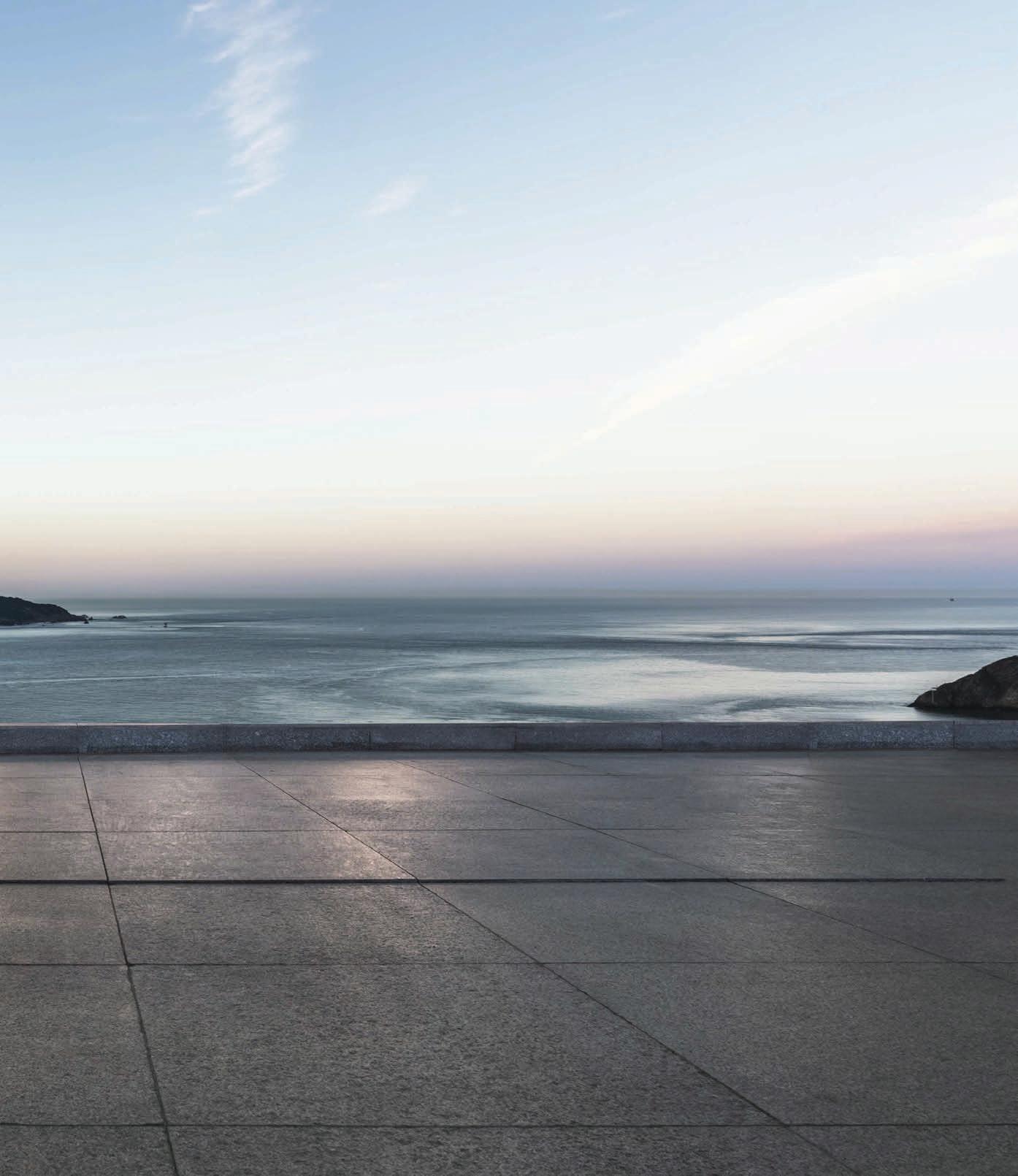




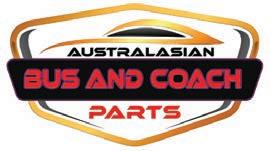


Following challenges over the past six months, Hino Motors Sales Australia (HMSA) has made the decision to withdraw the sale of its popular Poncho bus model in Australia.

In August 2022, Hino voluntarily chose to suspend the importation and sale of Poncho bus models in Australia.
Hino says the action was taken following the findings of a Special Investigation Committee that identified concerns around Hino’s processes relating to vehicle homologation and certification results in Japan.
Now, it is officially withdrawing the sale of the Poncho down under.
“Hino continues to believe that Poncho buses meet the relevant regulatory requirements for the vehicle,” Hino told ABC.
“We have made the difficult decision in light of the regulatory processes that apply to the recommencement of sales of a small volume of vehicles.”
The new NSW government has announced its ministers that will help look after the state’s bus and coach network.

Following last month’s New South Wales state election, the new NSW Labor state government has officially sworn in its interim ministry.
The ministers were sworn in at Government House Sydney in early April, with the transport and roads portfolios announced to look after the bus and coach industry in NSW.
Under new Premier Chris Minns and Deputy Premier Prue Car will be John Graham, who takes on minister for roads as part of his portfolio that also includes the arts, night-time economy and music.
Graham will take care of the state’s roads as well as emergency services, regional and western NSW, regional transport and roads and tourism alongside the Hunter and North Coast.
The other important ministerial appointment relating to the bus and coach industry
innovation.
Both Haylen and Graham are expected to play big roles in the future of the NSW bus sector.
The “Child Check-Mate System” is a patented unique alarm system which acts as an electronic reminder to drivers. This reminder helps ensure that all children have safely disembarked the vehicle upon completion of each run.


Our system was designed “by drivers for drivers” and it was the collaborative efforts of these drivers, a concerned operator and a talented bus mechanic which made the idea a reality. Ensure that no child is left behind in a school bus again. Get the Child Check Mate for your fleet.
For inquiries, contact United Safety & Survivability Corporation:
P: 0407 829 335
E: mick.hall@ussc.com.au
ussc.com.au
Queensland will continue committing to an electric bus future as it escalates its rollout in 2023.
The Queensland government has
announced that it’s increasing its electric bus fleet rollout as it plans to double its zero-emissions bus fleet this year.
Electrive reported that the Queensland
Just a year into the trial, on demand transport is clearly a roaring success on the Gold Coast.
In just its first year of running, the On Demand Transport (ODT) trial in the Gold Coast’s northern region has reached a milestone, with more than 50,000 trips taken since the service commenced.
The two-year trial, launched by the Queensland government in partnership with operator Kinetic in March last year, offers a personalised service seven days a week to and from key locations within the service area.
“The service meets the needs of a large group of regular users and continues to attract new users, with more than 9,000 app downloads for the service,” Queensland environment, Great Barrier Reef, science and youth affairs member Meaghan Scanlon says.
“Customers say they enjoy
that our on-demand buses offer a flexible public transport option, connecting people with essential services such as shopping centres, employment and health care; and also integrates with the Translink bus, tram and train network.
“The two-year trial in Pacific Pines and Nerang/Highland Park provides public transport coverage in locations where regular public transport services are not available or possible.”
Building on the success of the initiative, the Queensland government has launched a similar ODT service north of Brisbane.
Last month, Queensland Transport and Main Roads Minister Mark Bailey said the Hervey Bay service would align closely to the successful Gold Coast trial.

“The On-Demand Transport trial on the Gold Coast has been a roaring success so far and we’ve received a lot of positive feedback about it,” Bailey says.
“So it makes sense to roll out a
government is set to receive another 40 electric buses in 2023 to join the 25 existing electric buses currently serving on Queensland routes.
Queensland transport and main roads (TMR) minister Mark Bailey says the 40 electric buses will be introduced throughout the year to Moreton Bay, Brisbane, Redland Bay and the Sunshine Coast.
“We’re getting on with the job of rolling out more sustainable buses in Queensland to meet our zero-emissions targets,” Bailey told Electrive.
Electrive says four operators have currently come onboard to support this rollout, with Keolis Downer planning to launch 16 electric buses on Hornibrook Bus Lines’ network covering Moreton Bay, with a new depot being built for electric buses in North Lakes.

The Queensland government says Transdev is already phasing in 17 electric
The Translink On Demand app manages Gold Coast customer’s bookings easily, tracked where their service was and showed real-time notifications to see when services will arrive.
“It’s no surprise we’ve reached the 50,000 trip milestone within the first year as customers respond to the convenience and flexibility that ODT offers,” Scanlon says.
Using On Demand Transport ODT is free for seniors and veterans travelling during off-peak hours (8.30am to 3.30pm on weekdays and all day on weekends). To be eligible you must be a resident of the Gold Coast, and you must have a sticker on your Seniors go card.
Above:










Major Australasian bus transport operator Kinetic has announced it has signed a major financing deal with the New Zealand Green Investment Fund (NZGIF) to further decarbonise the country’s public transport network.
The NZGIF’s $50 million capex facility will finance electric buses and infrastructure for Kinetic and will form support for Kinetic’s strategic vision and sustainability goals in NZ.
Kinetic says it has plans to supports councils in transitioning public bus fleets from diesel to battery electric buses after already delivering more than 150 electric buses to NZ streets in partnerships with councils in Auckland, Wellington, Christchurch and Tauranga.
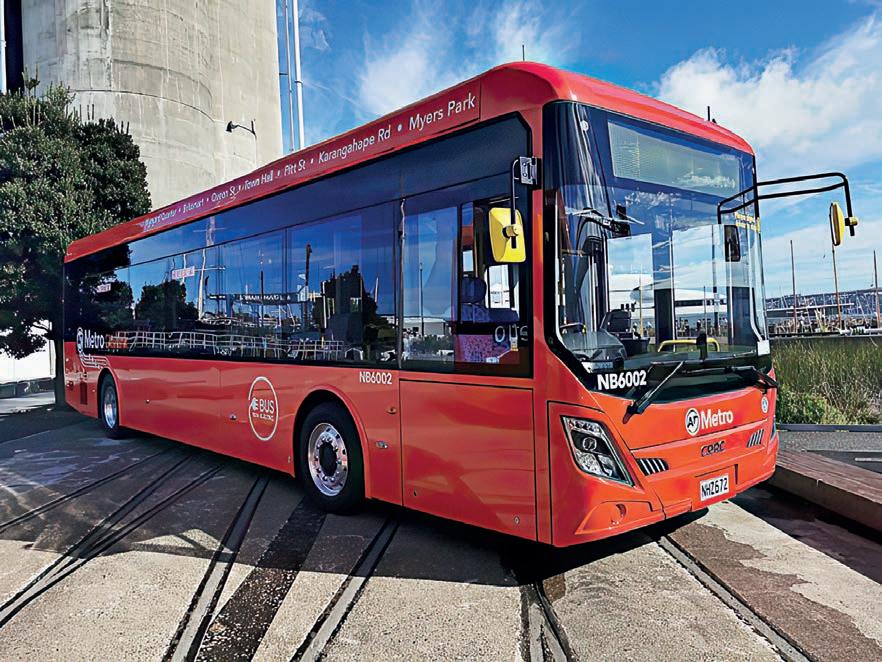
Back in January, Kinetic unveiled its first New Zealand fully electric bus depot. The Panmure (Auckland) site is home to 35 electric buses, which are among 152 the company will deliver in partnership with Auckland Transport over the next two years.
The NZGIF facility will be used to accelerate the decarbonisation of New Zealand’s public transport fleet and is enough to fund more than 150 zero-emission buses over the term of the facility. If fully drawn, the facility will help New Zealand avoid more than 100,000 tonnes of CO2 emissions over the life of the assets.
NZGIF Chief Executive Craig Weise says the deal is an important step for New
Zealand’s public transport system.
“If New Zealand is going to meet its CO2 emissions reductions targets, we’re going to need to dramatically increase the number of low and zero-carbon emissions buses on our roads,” Weise says.
“Only around five per cent of public buses in New Zealand are electric at the moment, so there’s room for a huge improvement. The technology is readily available but, until now, financing for the New Zealand market just hasn’t been there.

“We were established precisely to help catalyse these sorts of deals and to collaborate with other like-minded organisations to build a low carbon economy.
“It’s great to be working with Kinetic, which is not only one of the largest bus operators in Australasia, but one of the fastest growing as well. It’s already well established in New Zealand through its acquisitions of NZ Bus and Go Bus and we’re excited to be working with them and the broader lending syndicate to help reduce public transport emissions.”
Kinetic Co-CEO Michael Sewards says the support of NZGIF recognised Kinetic’s strategic vision and sustainability goals.
“The strength of our lending syndicate recognises the evolution and diversification of the Kinetic platform across Australasia,” he says.
Would you hop onboard a self-driving bus? Now’s the time to put your money where your mouth is. In Scotland, a world first has just launched, with self-driving buses to begin serving on Scottish routes. From May onwards, five single-decker buses will begin covering a 14-mile route over Scotland’s Forth Road Bridge. The catch is that double the staff will be onboard the bus, with two members needed to ensure the vehicles with sensors remains on the road and safe.
Up in Queensland, a new school bus service has seen school enrolments rapidly increase. As reported by ABC News in late March, Stonehenge State School in outback Queensland has recorded a spike in enrolments after a daily bus run began ferrying kids to and from the school. For some families who have to drive up to 30 kilometres down to the nearest bus stop, it’s a relief that the bus is taking school students the extra 70 kilometres to the school on one trip each way.

In Tokyo, a dog-friendly hotel has celebrated its one-year anniversary in style. To commemorate the successful venture, hotel Inumo Shibakoen by Villa Fontaine is offering a special cherry blossom-viewing bus tour for puppies and their owners on a dog-exclusive bus. With a non-slip wooden-style floor mat and spacious seating areas, the bus has ample room for dogs and their owners to take in the beautiful sights of Tokyo.

The yearly results of global trends shows Transdev is going from strength to strength.
In its annual results for 2022, global transport operator Transdev has reported strong growth in a difficult economic environment.
In an economic context marked by Europe’s energy issues and inflation, Transdev posted a net income of 20 million Euros, with its revenue growing by 10 per cent.


Transdev says 2022 confirmed the relevance of its strategic choices and marks a turning point for the Transdev Group with a strong recovery in activity, an increase in ridership in all its networks and strong commercial development, coupled with support of its clients in response to the energy crisis.
The group’s revenues grew by 10 per cent versus 2021, reaching €7.7 billion by 2022, with business outside France accounting for 65 per cent of group revenues.
In 2022, in terms of ridership, Transdev carried an average of 8.8 million passengers per day across all its networks, a strong recovery compared with 2021.

“The year 2022 was clearly a year of recovery for our group, despite an inflationary context and the energy crisis,” Transdev Group CEO and Chairman Thierry Mallet says.
“Thanks to the dynamism of our teams, we were able to win new markets, particularly in metros, where
our development ambitions remain strong.
“With the acquisition of First Transit, Transdev is changing dimensions in North America, in order to take full advantage of the growth in shared mobility and to accelerate the energy transition of our networks, in response to
environmental challenges.”
Alongside global wins in Ecuador and France regarding contracts, the First Transit acquisition is a major stepping stone for Transdev globally.
While its Australia/ New Zealand operations continue to excel, the North American region will be a primary focus for Transdev in 2023.
“Alongside global wins in Ecuador and France regarding contracts, the First Transit acquisition is a major stepping stone for Transdev globally.”

The Bus Industry Confederation Council (BIC) has recently made several major decisions that will impact the services that we offer members and inform future priorities. The first of these decisions was to appoint a permanent full time National Technical Manager. In February, Dean Moule agreed to jump aboard after working as director of product, industry and electromobility APAC at Volvo Bus.
Dean joins the BIC Secretariat in April and will be working with the rest of the team to strengthen and broaden our technical service offering. His work program is already significant, with priorities including supporting suppliers as we transition to zero-emissions through hyperinflation and a skills shortage crisis. He will also be grappling with the issue of local procurement and what ‘local’ means and is currently being mentored by our long-term technical manager Luke Hardy, who will continue to work with BIC as we finalise the first zero-emissions bus advisory and begin working on the next two.
that the strategic plan reflects the dynamic environment we’re operating in and guides the actions of the Council and Secretariat going forward.
The plight of supplier members has been on our radar, with an advocacy campaign underway to ensure that Australian governments understand the extreme pressure that suppliers are facing. Nobody would’ve anticipated a situation where suppliers have full order books but can’t make ends meet. We need governments to respond with changes in contract terms and effective and timely rise and fall variations.
This situation facing suppliers played heavily into the Council’s decision to bring the 2023 National Conference back on shore. Originally planned for Rotorua in New Zealand, the Council has decided to hold this year’s conference in Australia. We look forward to a fantastic conference at the Adelaide Oval from Sunday October 29 to Wednesday November 1.
Recently, the supplier’s group has made their concerns known to the Council about the 2024 Bus and Coach Expo being hosted by a state bus association that isn’t a member of the BIC. Drawing upon the various representations and the outcomes of an industry survey, the Council has decided that BIC will host a national Bus and Coach Show on September 17-18, 2024 at the Brisbane Convention and Exhibition Centre. We will shortly be releasing Expressions of Interest for exhibitors, presenters and sponsors and look forward to hosting this showcase event while adding extras that members asked for in the survey.

The Council has recognised the significant amount of change that the industry is undergoing and has invited representatives of the power and infrastructure sector to participate in the Council as observers. This observer status is likely to change to full Council membership later in the year as we amend the BIC Constitution.
Changes to the Constitution, which members will vote on, will be informed by a strategic planning process due to commence in April. This process, involving member input, will result in the first BIC Strategic Plan in many years. It’s important
The Council has also agreed to ramp up advocacy efforts to address workforce shortages. While there is a strong focus on bus and coach drivers, we’re also working with governments and other key stakeholders to address skill shortages among trade and technical staff. This includes addressing current and emerging workforce needs as we transition to zero emissions. We need real time data to build a compelling case for change, so ask members to share information as we advocate on your behalf.
Change is a constant. At BIC, we are working to ensure that this change is managed and that the services and advocacy we deliver reflect the changing needs and circumstances of our great industry.
The BIC is set to announce numerous new decisions regarding the future of the Australian bus and coach industry.
“Change is a constant. At BIC, we are working to ensure that this change is managed and that the services and advocacy we deliver reflects the changing needs and circumstances of our great industry.”
I(ARCC) hasn’t been a typical zero-emissions bus and coach manufacturer.
The ARCC staff was significantly involved in the design and deployment of the building of its first aluminium body on a Toro electric bus for Sydney Airport and additional units for Brisbane Airport in 2015. The learnings gathered from these projects were the genesis of the concepts that ARCC’s engineers and management team saw as an opportunity to revolutionise the future of Australian zero-emissions bus and coach manufacturing.
“We decided to chase reducing kilograms rather than adding kilowatts, using the ethos of doing more with less,” ARCC founder and managing director Peter Murley told ABC.
“Our goal was to achieve at least a two-tonne reduction in the overall GVM of our bus, envisaging a disruptive technology that addressed and solved a number of challenges that the industry faces.
“We chased weight savings,
opportunities with existing industry members and service providers, with the goal being to redesign the way zero-emissions buses can be conceived, built and operated in Australia.”

Murley’s ARCC journey began when the company was founded in 2016. Seven years ago, he realised the growing tides of a zero-emissions bus transition and went on a fact-finding mission to the only nearby country that was already successfully implementing electric transport – China.
After visiting several electric chassis manufacturers there, one key fact hit home.
“The largest electric bus chassis manufacturer was great at building batteries, but not buses,” Murley says.
“We witnessed large deployments of zero-emissions buses with charging infrastructure to match, but the power to charge them was generally sourced from coal power stations, which in our view was basically just emissions shifting.”
The manufacturer’s ideas for zero-emissions buses centred around
significant savings in terms of weight, manufacturing time and capital investment in a model that was also agnostic to the drive energy source.
In conjunction with long term colleague, engineering manager David Evans, Murley set clear goals for what he wanted ARCC to become and the team he wanted to build to deliver the solution.
“What ARCC does is challenging and very few engineers have the experience or skill set to deliver on the unique concept we wanted to create,” Murley says.
“Hence David began building a team of engineers comprised of experienced personnel while also using associations with tertiary education institutions to develop an engineering intern program that has been very successful.”
The core engineering team is comprised of hydrogen specialist Chetan Koniki, mechanical engineer Mladen Vojvodic, aftersales support and homologation Kienan Bray and electrical engineer James Mitchell. It’s this mix of experience and
In just its seventh year as a company, technology and manufacturing brand ARCC is continuing to accelerate its future thinking when it comes to redesigning the way a zero-emissions bus should be built
ARCC. The mantra of the business focuses very much on an alignment with the industry, regulation, custom and practice while addressing participants’ goals and aspirations around the transition to zero-emissions vehicles.
“Our experience has taught us that you must act in collation with a range of industries,” Murley says.
The bulk of ARCC’s technology, research and design has gone into developing this software that is agnostic to both hydrogen fuel-cell and battery electric buses – a novel concept in the Australian market. Murley says that from the roof down, both fuel-cell and electric ARCC models are the same, with the interchangeability of the ARCC design futureproofing the vehicles.
“By providing this complete solution, we think our philosophy is unique when it comes to zero-emissions bus technology to
help the industry transition to a competitive sector that is stable in the long term,” he says.
“Our goals are very much focused on the government’s route bus market, but our technology not only lends itself to buses. It can be deployed in other aligned industries, such as trucks, mining and agriculture, which we see as future opportunities.”
After COVID-19 disrupted ARCC’s momentum significantly, the manufacturer is starting to ramp up its production.

Yet challenges still sit in the way. A lack of settled policy on zero-emissions charging and refuelling infrastructure and how it is to be providedand maintained means ARCC is part of an industry that will continue to be behind global rates of transition.
“While we transition to a
closing down mainstream sources of energy in coal and gas-fired power stations,” Murley says.
“We’re conscious of the issue we’ll have if power generation falters in Australia – people may not understand how buses are part of a larger energy ecosystem that requires plenty of power.”


It’s this long-term thinking that has given ARCC a competitive advantage in the market. ARCC has aligned itself with investment company Macquarie Group and energy company Origin Energy. Murley says these partnerships provide expertise and experience
Above: The design uses an aluminium f rame that is modular to power source
Below: ARCC specialises in both battery electric and hydrogen fuel-cell buses
Opposite, Top: ARCC is tapping into the next generation to lead it forward
What ARCC does is challenging and very few engineers have the experience or skill set to deliver on the unique concept we wanted to create.
that the industry can utilise to develop integrated turnkey solutions addressing energy and infrastructure challenges.
The company ethos has been founded on this humility, yet its design is anything but understated.
Murley says ARCC’s concept is set to capitalise on several industry-specific trends by providing a lighter model that doesn’t negatively impact on passenger capacity while reducing the need to increase battery capacity.
“Research we’ve undertaken
benefits associated with smaller battery packs, including faster charging capabilities.
“If you have the right infrastructure, it can be a next-generation solution to overcome overnight charging issues.”
This forward-thinking approach is similarly applied to hydrogen fuel-cell vehicles. Although battery electric buses are more popular currently, Murley sees a future where the similarities between hydrogen and diesel makes it the preferred option for government route bus operators.
Murley says the roll out of infrastructure to support a large scale deployment of hydrogen vehicles, be it commercial or passenger, is some way off.
This increases the importance of the trials that ARCC is involved with
makes zero-emissions transport as convenient as driving diesel vehicles,” Murley says.
Murley admits many of ARCC’s design benefits are not yet visible for its target audience. He’s playing the long game and waiting for the technology to develop in the infrastructure sector to match the benefits that ARCC’s modular and scalable electric and hydrogen bus chassis provide operators.
“Our mission is to lead the sector by adopting technological advancements for a wide-scale solution that decarbonises the transport sector with a focus on government route buses while also rethinking manufacturing practices,” Murley says.
“We see our design making travel for passengers clean and quiet and our design being highly configurable to suit different routes while reducing energy usage.”
This local manufacturing emphasis extends beyond software and technology designs. Murley employs seven engineers, with only two of them being above the age of 35. While getting zero-emissions designs right is critical, he recognises the need to invest in the next generation of experts.
“ARCC recognises that its people are unique and committed,” Murley says. “The current tight labour market means it’s essential that we put in place processes that ensure our workforce is well communicated to when it comes to company direction and priorities.
There are many lessons that Murley has learnt as ARCC has grown. In just its seventh year, ARCC has thrived without any government support or grants.
By ‘doing less with more’, Murley is confident ARCC’s clever approach will pay rich dividends for the Australian and global zero-emissions bus market.
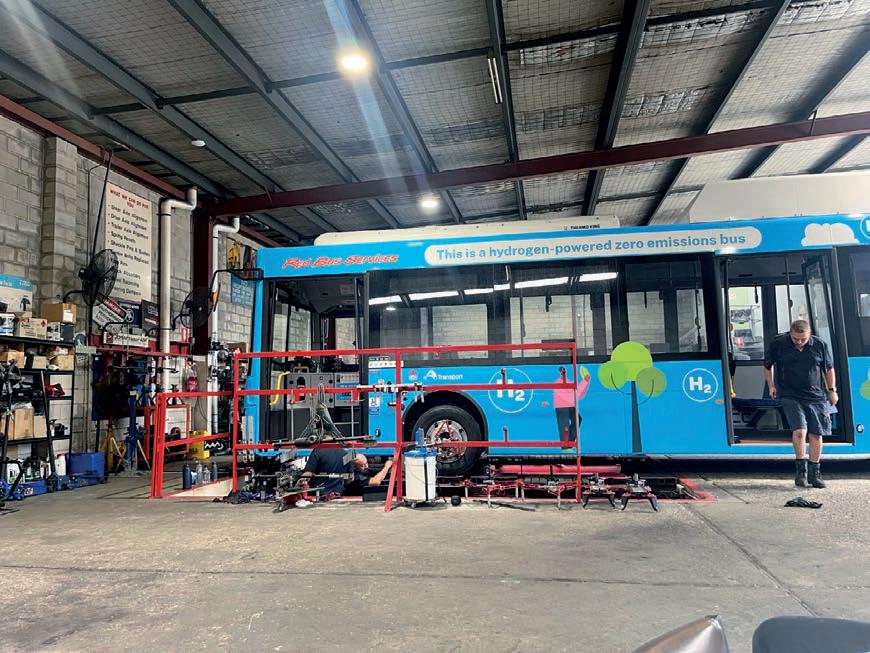

“Our current and future focus is all on generational change, both in terms of employees and ideas,” Murley says.
“I’m confident we will continue building a solution that can be deployed in any situation that is needed both now and in the future.”
Above: Murley and his team is thinking laterally when it comes to
We want to create a solution with the right infrastructure that makes zero-emissions transport as convenient as driving diesel vehicles.

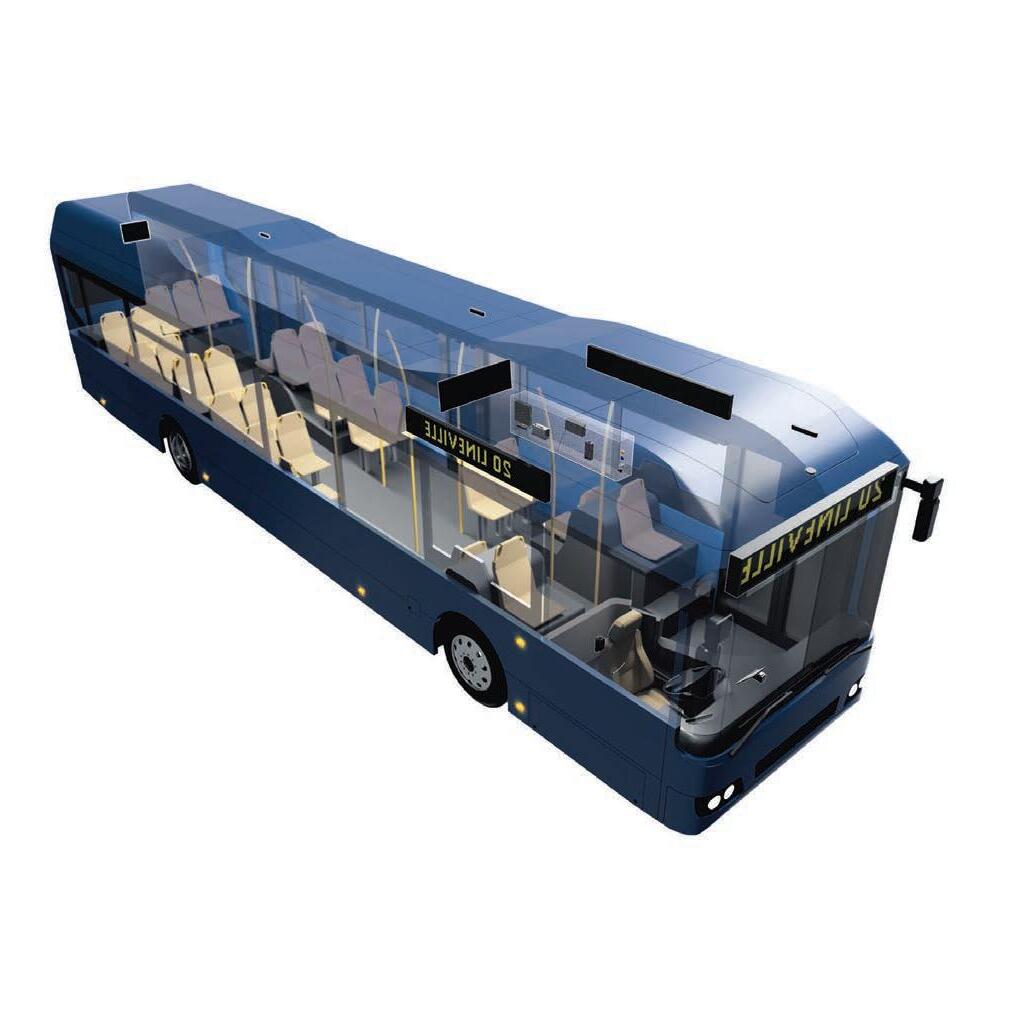









Some people are born into family empires that dominate certain industries. Glynn Ross was born into a family legacy that ran buses. He may have deviated from the bus game over the years, but this passion for buses over generations of Ross men meant he was always destined to forge a successful career in the industry.
“It’s always been in our blood that we took over different bus companies,” Ross told ABC. “We were always taught to be hard-working and how to run buses effectively.”
Ross’s origins were fit for a shrewd and effective bus operator. He describes his father and idol Glynn Mervyn Ross as a hard-working and astute man who taught him how to live on a tight budget. For the Ross family, there were no rich buses like a Bedford – it was all about the Leylands and enjoying the battle of running small family-owned bus companies.
Glynn Mervyn Ross successfully owned and operated several buses in the Toowoomba region, the birthplace

of famous former operator McCafferty’s Coaches, between 1960 and 1980. When his son grew up in the region around buses, the family love for buses and coaches was soon passed down.
Ross’s voice spikes with fondness as he reminisces his first memories of a bus. As a child, Ross used to ride with his father while he completed the Saturday night runs to and from the local cinema. Buses wouldn’t exceed 50 kilometres per hour and didn’t have air-conditioning supplied. Even without these luxuries, buses remained at the heart of the Ross family.
As he got older, Ross was always just as infatuated with buses as his father was. Yet when he finished school, before he could even consider a life in the transport industry, his father sprung a shock on him that would change his life and career drastically.
“When I finished school, my father wanted me to get a different career and I listened to him,” Ross says. “He told me that the bus industry is a case of ‘here today but gone tomorrow’, so he made me get that background experience in case tomorrow came
WORDS SEAN MORTELL IMAGES GLYNN AND JANE ROSS
Even when diverted, Glynn Ross’s life has never strayed far from the bus industry. It made it incredibly difficult for him to decide to sell Coolum Coaches to another family-based operator.
and the business was gone.”
So the bus-nut had to shelve his passions and look elsewhere. Instead of helping his father run a business that grew to around nine buses, Ross attended university for four long years to become a teacher.
For the next 20 years, Ross was a teacher and headmaster while raising a family. Throughout this time, his passion for buses was kept intact by doing extra driving on the weekend. Sometimes he would even take the kids to school on a bus, teach them all day and then drop them back home. His father may have deviated him away from buses, but they always remained linked to his life.
His wife Jane describes him as “a natural workaholic” who would return home from teaching only to go and take over bus driving shifts at 4PM to complete afternoon runs.
“It wasn’t unusual for Glynn to do a big drive through the night, barely sleep and then go teach at school,” Jane Ross told ABC. “He’s such a go-go-go man and he’s always been into buses, plus he had a genuine passion and respect for buses, so he was there day in, day out to help out.”
After 20 years in the state education system, Ross decided in the late 1990s that he was done with teaching. This thirst for change, alongside perennially sick kids, fuelled his decision to move
his family up to the Sunshine Coast and buy Coolum Coaches in 1999.
On February 1 that year he officially took over the operator. Immediately a serious weather event marred the exciting move.
“The year we bought Coolum Coaches there was incredible flooding,” Ross says. “There was seven foot of water running out of Coolum.”
When the water receded and the sun returned to the Sunshine Coast, Ross became part of a competitive bus landscape. With a dwindling number of operators fighting to stay afloat, Ross’s intense working habits went into overdrive as he amassed a number of school bus contracts for Coolum Coaches.
Each day, Coolum Coaches buses would transport more than 1250 kids to and from school safely, servicing more than 15 schools around the Sunshine Coast. At its busiest period, Coolum Coaches would transport more than 1750 kids.

“But Coolum Coaches didn’t just look after the kids,” Ross says. “It looked after my family, fed them, put them through school and put clothes on their backs.”
Ten years after first buying Coolum Coaches, Ross took another step forward in a bourgeoning bus career. On November 2, 2009, Ross completed the acquisition of the North Stradbroke Island Buses.

The idea was for the Stradbroke side of his business to help boost his super and allow him to retire with less stress. When it came to buying the business, previous owner Bryson Swan kept delaying the sale until Ross forced him to come with him to Queensland’s transport department to change the ownership into his name.
“As we were about to enter, Bryson Swan stopped and sat in the gutter and wouldn’t move any further,” Ross says. “I had to push him into it, it was like selling his family.”
Under the new conditions, Ross would go to the depot and drive buses for Coolum Coaches from Monday to Friday before heading to Stradbroke Island on the weekends to help run the business.
The process wasn’t easy to head to and from Stradbroke. Ross would pack and organise himself before driving his car onto the barge and heading to the
island to stay for the weekend before doing the reverse on the way back.
“Stradbroke was such an interesting community,” Ross says. “It had different needs and wants compared to the mainland, but it was full of such nice people.”
It took a decline in Ross’s health for the juggling act to end. When his health began to worsen, Ross had to follow in the footsteps of Bryson Swan and make the tough decision to sell North Stradbroke Island Buses.
Yet it paled into comparison to what would come next. A couple of years ago, Ross decided to begin the process of selling Coolum Coaches.
“Due to changes in my health, I had to sell the business, but some would say I should’ve sold the business a long time
ago,” Ross says. “However, I’m a natural workaholic and was just too proud of the chance to call Coolum Coaches my very own.
“I still sometimes say I shouldn’t have sold it because I’m so devoted. I didn’t want to let go of it, but it became too hard and life moves on.”
After a lengthy process, Ross decided to sell Coolum Coaches to another family bus operator in Thompson Bus Services earlier this year. Ross had multiple options when it came to selling the company, but he chose peace and ensured Coolum Coaches went to another family business.

“We’ve known the people at Thompsons for a long time and it was relatively easy, as we knew it would be in great hands,” Ross says. “When they put on a farewell event for me, they noticed that I already
looked better without the stress of running the business.”
It wasn’t an easy farewell, but Ross now gets to enjoy retirement with a raft of terrific memories. He says he has been fortunate to be associated with such a great industry filled with wonderful characters. It’s the small things that will stick with him the most.
“Coolum Coaches and running buses was my identity,” Ross says. “My favourite times were washing the buses and buying new ones, as well as shouting my workers Friday afternoon drinks.
“I’ve been a bus nut for the best part of 30 years. It’ll take me a hot minute to realise what retirement means, but after conquering cancer and improving Parkinson’s, I’m sure that with the help of Jane I’ll figure it out in no time.”
It wasn’t an easy farewell, but Ross now gets to enjoy retirement with a raft of terrific memories. He says he has been fortunate to be associated with such a great industry filled with wonderful characters.
Powerful, expandable and redesigned from the ground up

Inexpensive and reliable (near 0% failure)
Simple installation
Most complete data from vehicles
OX expandable
3D gyroscope and 3-axis accelerometer

Collision reconstruction
Reverse & harsh brake detection
Electric Vehicle Suitability



Assessment Tool
Smart Cloud Portal & OCPP
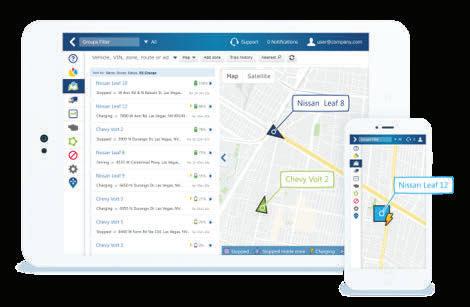
Capability
Remote Update & Diagnostics
Weather Resistance
Easy to Install & Service
Providing electronic, electrical and technology solutions from supply to production and beyond.
Jeff O’Meara’s first memories started with a school bus and, nearly 67 years later, it continues to revolve around running school bus services. After decades upon decades of unwavering service to Wonthaggi locals and the surrounding regional Victoria communities, Jeff was deservedly rewarded last year when he was named as joint winner of the Bus Association Victoria’s (BusVic) School Bus Driver of the Year.
“I was surprised, a bit embarrassed and also humbled to be a joint winner of the award,” he told ABC. “It came as a complete shock – I have only done what I thought was best for the children and to be rewarded in this way was humbling.”
It may seem like he always wanted to be a bus driver, but this couldn’t be further from the truth. His time on a bus began in the middle of 1956 when his mother decided he wasn’t learning anything at the one-room, one-teacher school at West Creek, so she enrolled him at North Wonthaggi Primary School.

Jeff was soon dropped at the school gate and told to walk down to the Korumburra Road corner to catch the afternoon bus back home three miles to Wonthaggi. It was the start of the young student’s love affair with buses, even if he never thought he would end up being a bus driver.
“I remember that first bus, a 1946 Federal, that duly arrived and took me on my first trip on a bus,” he says. “The bus stopped at our front gate then drove off with me still aboard – I didn’t know I had to open the old mechanical door myself.”
It was the first of many lessons for Jeff on a bus. This initial foray may not have showed him the ropes of customer service, but he was soon transferred onto a different school bus driven by a man named ‘Ducky’.
Over the next 11 years, he was taken to and from school by “a great chap” who provided the silver standard for school bus drivers. Despite this role model to look up to, Jeff wanted to work in the railways as a loco driver.
Instead, he wound up working in the local Holden garage. In 1974, just before
When Jeff O’Meara first started hopping on school buses as a kid, he never wanted to follow in the footsteps of the driver. But chance circumstances meant he was drawn into a rewarding career in the bus industry.JEFF O’MEARA OPERATOR
his wedding, the business went broke and his career took an unexpected pivot.
“My now wife of nearly 49 years, Rose, married me while I was unemployed,” he says. “But all was not lost – the father of the panel beater at the garage who had also lost his job offered me a role.”
The employer, Albert, was a contractor who also operated the Cowes-Ventnor-Wonthaggi school bus service with an old 1966 Comair Bedford – the same bus model Jeff used to take to school just five years prior. In the early months of 1975, Albert told him to get his DC licence to drive the bus.

He remembers Rose bringing the important envelope up to the workshop and opening it with him. That night, he was driving the bus, but not without challenges.
“I knew the bus route, but I had to ask the kids where the stops were,” he says. “This started some long days, driving the bus morning and night and also building the power lines in between as part of the other contractor work.”
Before Jeff was to go on his first trip, Albert passed on three key rules for driving a school bus: “Rule one: keep the kids safe,” he says. “Rule two: keep the kids safe. Rule three: refer to rules one and two.”
After successfully memorising and abiding by the three key rules, Jeff spent the next few years driving the Bedford and dealing with poor brakes, vaporising and blown head gaskets. From his early memories of driving the bus, he summised that the kids approved of him because he was able to manage the ENV five-speed crash gear box.
Yet this wasn’t a permanent stint in the bus industry. Circumstances changed and he was out testing poles and inspecting SEC lines. Just over 20 years later, he would be told that his workplace was crashing down after privatisation. On
October 15, 1996, his position as a major plant operator in Wonthaggi was made redundant. Three days later, he was out of a job.
On the way home, he despondently visited his old boss Albert to tell him the news. Upon hearing the change, Albert agreed to an offer that would forever alter Jeff’s path.
“I asked whether I could buy the bus run, to which he agreed,” he says. “Albert’s generosity in agreeing to sell the contract let me back into the bus industry.”
On December 1, 1996, Jeff and Rose started on the newly acquired bus run in a 1316 Mercedes-Benz. As it was near the end of the school year, only the younger students were still taking the bus. Jeff would be in for a shock on his first day on the new run.
“I arrived at a stop on the first morning and a young girl was
waiting for the bus,” he says. “I asked her name, and to my surprise, she was the daughter of one of the boys I had taken to school years before.”
It may seem like a return to the bus industry was always written in the stars for Jeff, but he faced challenges to get back. He says the biggest hurdle was having to complete six accreditation exams on material that largely wasn’t relevant to what a regional school bus operator does.
All went well until nearly a year later in August 1997, when a secret review of the Wonthaggi school bus network found that two buses had to go from the fleet. One operator was set to finish and duly departed, leaving the final bus to go up to Jeff and one more. As their contracts were signed on the same day, they had a month to sort it out.
“As I had known them for many years, we hatched a plan
for me to buy him out,” he says. “We stepped up into a 1994 Hino RK for the start of the 1998 school year.”
Having bought two contracts, it was a tough few years financially for Jeff and Rose. Yet for the next decade, they made do and forged a living with the school bus run.
It took 11 years for the next roadblock to present itself. The Hino RK had performed trouble-free for them up until a chance phone call from Public Transport Victoria’s (PTV) regional manager in Traralgon, who suggested that the 49-seater wasn’t coping with
the rise of students on Phillip Island.
“Wayne asked if we would consider upgrading to a 61-seat bus and we agreed,” Jeff says. “In late 2008 we settled on a new bus that was delivered in February the next year.”
The new bus was a completely Australian-built IVECO chassis from Dandenong, Victoria that had an Express body from Macksville, New South Wales fitted on top. It had an immediate impact on the growing number of kids he was driving.


“The new bus was a great move –the kids absolutely loved it,” he says. “The air-conditioning made the ride enjoyable with no window fogging, there was no more suspension squeaking and the engine conquered the hills with ease.”
It’s continued to service Jeff well all the way up to his deserved BusVic award last year. Upon receiving the award, he says he was transported back to the best parts of driving school runs each day.
“I love driving the bus and interacting with the kids and watching them develop from shy Year 7’s to confident teenagers ready to head out into the world,” he says. “I never had any trouble with the hundreds of kids I transported to school, they mostly complied with the rules.
“I respect them all as they find their own way in life, and it means they respect me. I’ve been privileged to be a small part of their lives.”
Jeff’s influence on the many school
kids he has driven is clear. One of his passengers, Alison, asked him to drive the wedding car for her on her special day, just like he used to when she was going to and from school.
For an operator that lives and breathes the school run, he has had his fair share of tragedies. He says he recalls finding out that certain students had tragically passed away or suffered accidents that completely changed their lives.
When one particular kid tragically became a quadriplegic, he remembers the BusVic team helping to raise several thousand dollors to buy equipment that made his life more bearable. It’s clear the fondness that Jeff has for his passengers has made him a cherished member of his local community.
The benefits and heartwarming moments have made him very grateful for falling back into the bus industry. Now, after receiving his BusVic award, he’s pondering the final stages of his career and says he can’t help but feel fortunate for the career he has had driving buses.
“After operating our service for more than 26 years and holding my DC licence for 48 years, perhaps another direction beckons,” he says. “Being a driver for a regional school bus has been great, I’ve made lifelong friends along the way.
“At my age, I do think about retirement and my future plans with Rose – who knows what’s in store!”
Consat Telematics’s development of smart systems for public transport include fleet management, traffic management, zeroemissions vehicle and charger management, Push To Communicate and passenger information systems for a large number of customers worldwide. All of this is being put together on Consat’s new diverse web application.
When Consat Telematics managing director Lachlan Mackay sits down with Australia’s bus and coach operators to discuss Consat’s wide range of telematics systems, there’s plenty to discuss.
From fleet management to passenger information systems, Consat has a growing suite of solutions for the local market. Yet it’s Consat’s Fleet Studio web application that Mackay finds comes in handy more often than not with Australian operators.
“Operators often ask us what our Fleet Studio technology can do,” Mackay told ABC.
“I often answer with a question of my own – ‘what are your pain points?’ and we quickly can determine how we can help them out with Fleet Studio.”
It may not be one of Consat Telematics’s most common applications for the bus and coach industry, but Fleet Studio is quickly proving itself as Consat’s ‘swiss army
knife’ of solutions for the sector.
Consat Telematics’s Fleet Studio is a web application built from the ground up for transport operators to manage public transport fleets.
The application can be used on a control centre desktop, a workshop tablet or on a mobile phone to provide an easy use for operators constantly on the move.
Mackay says Fleet Studio provides a host of functions and solutions to meet an operator’s needs, ranging from real time tell-tale alarms, route tracking and on time running data to electric bus energy consumption information and control of electric bus chargers at the tap of a finger.
“Fleet Studio provides key information that a public transport operator needs in their daily operations,” Mackay says.
“This includes practical information such as the vehicle’s use, wear, consumption and faults.
“Consat Telematics’s connected vehicles enable bus operators to constantly monitor all of this information remotely in real time. It also

provides historical data for them, such as alarms from the past hour, day or month.”
To a member of the bus and coach industry, there may seem like there is an abundance of new telematics software hitting the market. So what makes Consat’s newly developed Fleet Studio web application different?
Mackay says Fleet Studio is incredibly powerful because it can combine with the onboard hardware of a bus to replace many systems, giving operators more value for money compared to running numerous devices that take up precious space.
Recent customer business cases have proven this point, with customers saving money while using the web application.
“A positive return on investment is very attractive,” Mackay says.
“Customers may initially want a certain Consat system, but with Fleet Studio they will get a wide range of solutions from the one application that can significantly lower costs.”

It’s this diverse range of applications and capabilities that makes Fleet Studio such an exciting release for Consat Telematics and Mackay. He says Fleet Studio’s ability to provide fleet and traffic management alongside driver behaviour monitoring and CCTV alarm integration makes it an attractive package for customers.
“Customers quickly realise that with Fleet Studio they also get other features, such as driver behaviour monitoring and electric charger control, all within the same system,” Mackay says.
“This reduces the number of systems required on a bus, both on and off-board.”
diesel buses; bus manufacturers are often reluctant to provide real-time information on the vehicle’s drivetrains, which is essential for good monitoring.


“But with the transition to electric buses, requirements are increasingly being imposed for things like charging management, which opens up opportunities for us,” Skangic told ABC.
“The chargers give us data on how much the buses charge each

“The chargers give us data on how much the buses charge each time and, of course, we know where they drive. This enables us to calculate their energy consumption, regardless of how much information the bus manufacturer chooses to share with external systems.”
to Fleet Studio, including online traffic management updates that will benefit Australian operators by allowing them to access a bus’s data on a phone during emergency situations.
Consat’s current focus for Fleet Studio has been to make it manage both diesel and zero-emissions buses in the same app. Mackay says the app is able to handle electric buses, including bus charging, by enabling the calculation of energy consumption for the buses because the application knows the vehicle’s mileage and receives data from the chargers when the bus is charged.
The application can also record data on driving style, how often and for how long the doors open and if the vehicle has something broken, among many other functions. Mackay is excited by Fleet Studio’s ability to collect many kinds of data depending on the customer’s wishes.

The changes have already started to roll out onto Consat Telematics’s versatile web application for vehicle management. The Driver Coaching report in Fleet Studio

provides timely information for both drivers and managers.
The result is two essential metrics in energy consumption and passenger comfort. Mackay says these values are linked; for example, if a bus drives with harsh breaking or cornering, the vehicle not only consumes more energy (and increases wear on the road and vehicle), but passenger comfort lowers. This is where additions to Fleet Studio can really make a difference for Mackay and his team at Consat Telematics as its ‘swiss army knife’ continues to impress.
“Driver Coaching demonstrates the underlying goals Consat has for Fleet Studio,” Mackay says.
“The most important values should be easy to understand for the intended customers, as drivers should be able to log in and analyse their runs by themselves.
“Fleet Studio is the result of a committed and highly competent team and has become a global success with many operators and transport authorities around the world.”
“Consat’s current focus for Fleet Studio has been to make it able to manage both diesel and zero-emissions buses in the same app.”
There is no single solution to sustainable transport but it’s clear that renewable energy and hybrid technology play an important role. In fact, on some types of routes with frequent stops, hybrid buses simply can’t be beaten when it comes to both carbon and overall emission reductions, as well as fuel economy.
Our Euro 6 diesel electric hybrid is a multi-purpose solution that lets you run the same high-capacity buses on suburban and suburb-to-city routes alike – even in the most challenging terrain.

And increasingly available locally produced biodiesel enables you to combine hybrid technology with renewable fuels, safeguarding your fuel supply whilst also reducing CO2 emissions by a staggering 80%.
Scania Hybrid, your commercially sustainable bridge to a zero emissions future.
For more information contact:
Jamie Atkinson: 0408 059 501
Ian Clarke: 0438 482 492

www.scania.com.au youtube.com/ScaniaAustralia
Scania currently have vacancies for diesel technicians, please go to our website to find out more.
Connect Source has quickly built upon its strong foundations as an electric component manufacturer. Now, it’s combining telematics with cutting-edge electric vehicle charging technology to provide a unique combination to Australian operators.

The rise of technology in the bus and coach industry means telematics offerings are only growing and diversifying. When it came to providing innovative solutions for the growing electric vehicle market, Connect Source looked to cultivate a unique option for bus and coach fleet managers.
After specialising in electric component manufacturing during its 25-year history, Connect Source decided to start a technology business in 2016 that grew to a novel way of servicing the zero-emissions transition.
“We thought that the whole turnkey solution with telematics and electric vehicle charging was only going to increase in the coming years,” Connect Source national channel and customer experience manager Stephen Chapman told ABC.

“We know it needs to increase to meet Australia’s carbon emissions goals and we wanted to be a strong player in that space.”
So Connect Source took a gamble. Just last year, the leap of faith materialised in Connect Source becoming an authorised reseller of Geotab’s telematics solutions.
In a global market, Geotab provides telematics that monitors over-speed, braking and driving patterns to maximise the efficiency of vehicles.
Yet Connect Source’s main focus is not really on that side of telematics. Instead, Chapman says the company narrowed its focus on a unique part of Geotab’s catalogue.
“We were really wanting to get involved with a little electric vehicle suitability assessment tool that Geotab sells,” Chapman says.
“We already have partnerships involved in driver fatigue and distraction
technology, as well as dashcams when our clients have requested them, but this was a new field for us.”
It would form the first step of what would eventually crystallise into Connect Source’s complete turnkey solution, starting with electric vehicle telematics and including electric charging infrastructure offerings in a unique concept for the bus and coach industry.
The Geotab electric vehicle suitability assessment tool answers the first query that a fleet manager will have when considering the electric vehicle switch in what vehicles are available and which models are best for their operation.
In the first step of Connect Source’s offerings, the Geotab electric vehicle suitability assessment tool allows fleet owners to do their own homework and make informed decisions about which electric vehicle models are the best for them. By plugging into the vehicle’s computer and running for a period of between 30 and 90 days, the system uses actual data to recommend an electric vehicle model based on comparisons with more than 210 different models in the system.
“This tool updates every month as new models come out and gives broken-down assessments to match the right electric vehicle with an owner,” Chapman says.
“Once they go and invest in the electric vehicle, we then use Geotab’s suite to provide the next step through the whole new game of telematics for electric vehicles.”
This is where Connect Source’s decision to become an authorised reseller of Geotab products comes in handy. After originally using the partnership to resell the electric vehicle suitability assessment tool and start a fleet manager’s zero-emissions transition journey, Connect Source then uses all of the leading features included in Geotab’s telematics solutions.
All of these tools provide a comprehensive offering for new battery electric bus owners,
Above: Connect Source is distributing Autel Energy chargers as part of its package Opposite, Top: Connect Source is combining telematics with electric vehicle charging technology

starting with a simple plug-in of the telematics device into the computer of the vehicle. From there, extensive reporting will help keep the bus efficient and as cheap to operate as possible.
When fleet owners then naturally progress to the next step of scaling up to more electric buses in their fleet, Connect Source can use the Geotab product to guide customers through the decision-making process of optimising their fleet.
“We can use the solutions to scale the electric side, optimise energy and meet carbon reduction goals that our customers want to achieve,” Chapman says.
“We’ve gone into reselling the Geotab telematics packages as we believe it’s a great tool that we can use to help fleet managers to manage the zero-emissions transition process really easily at any stage of the process.”
This technology and package isn’t a unique idea in the electric vehicle telematics market. What makes Connect Source’s solution so different and valuable is what it decided to do next.
After working with Geotab to provide a comprehensive suite of electric bus assessment and tracking technology for Australian operators, it didn’t rest on its laurels. Instead, Chapman and the Connect Source team moved right
We know it needs to increase to meet Australia’s carbon emissions goals and we wanted to be a strong player in that space.
to benefit the local bus and coach market. But his team didn’t stop there.
After developing its own back-end platform, Momentum, for the Guardian fatigue management technology, Connect Source did the same with the integration of Geotab’s telematics. It then went a step further by replicating this process with Autel’s electric charger back-end systems, integrating them into the same platform to enable fleet managers to access an array of different systems in just the one platform.
onto the next step – electric bus charging.
Around half a year ago, Connect Source announced a second partnership, this time signing a distributorship with Autel Energy to sell their MaxiCharger range of electric vehicle chargers.
It allowed Connect Source to offer a complete electric bus technology combination that puts it in rare air in the local market.
“We thought that if people moved towards the electric bus space and used the tools we provided to help select the right electric vehicles to begin with, then we needed to progress to supplying the right charging infrastructure to charge their fleets,” Chapman says.
“This new distributorship with Autel Energy allows us to offer the turnkey solution from woe to go that we desperately wanted.”
This wasn’t a quick process. Connect Source started this next phase of its evolution by investigating the complete range of electric vehicle charger brands and manufacturers in the Australian market before signing with Autel Energy.
Chapman says the complete and diverse range that Autel offers swayed Connect Source, with the energy company providing smaller 7.4kW at-home chargers for garages through to an impending release this year of a 480kW fast charger for heavy electric vehicles, as well as everything in between.
“They just released a 47kW mobile charger that I think will be ideal for every bus depot across Australia,” Chapman says.
“We also love how Autel’s chargers are modular – customers can add an additional 20kW modules into them to progressively increase the power in the
charger as they scale up their fleets.”
Chapman says the quality of Autel Energy’s charging manufacturing also stood out, with the 36 and 24-month warranty offerings for AC and DC chargers respectively and their commitment to innovation reassuring Connect Source that Autel was the right company to partner with.
Yet it’s a visual factor that had Connect Source excited to showcase its Autel charging range at the recent Fully Charged LIVE show in Sydney.
The end result is a modular system that can provide a world-class back-end platform for any fleet management, telematics or electric vehicle charger solution, meaning Connect Source can apply its complete electric bus package to a growing number of vehicles and chargers.
“We’re really excited with how everything is going,” Chapman says. “We’ve already installed a number of both AC and DC chargers in Australia and are on the preferred suppliers list with the Western Australian government.
“Our aim is to be on that list for every Australian state and territory. Seeing the uptake of electric buses in Australia makes us excited that we’ll follow other
Autel’s chargers have an LCD screen on it and can be carted around on wheels to be a mobile power source for electric bus batteries. It quickly became a hit for Chapman and the Fully Charged crowd.
“The launch at Fully Charged was very successful,” he says. “Lots of people commented on the LCD screen and loved that it was mobile. It’s such a slick looking charger.”
This combination of Autel’s new charger technology and the incredible depth of Geotab’s telematics information has made a wonderful match for Connect Source. Chapman says Connect Source always had a goal of linking electric charging with a telematics package to create a unique total offering.
He says it feels rewarding to have succeeded in going further as a company
countries and experience an electric technology boom.”
Once upon a time, Connect Source was just an electric component manufacturer. Now, it has delved into the deep world of telematics and combined solutions with innovative electric vehicle charging infrastructure to provide sustainability. Chapman looks forward to seeing where the technology boom will take Connect Source next.
“It’s a really exciting time with how the electric bus transition is going, as the technology is only getting better and better,” he says.
“All indications tell us that there are a huge number of bus companies looking at changing fleets over to electric buses and we’re ready with our unique systems to capitalise on this trend.”
Our aim is to be on that list for every Australian state and territory. Seeing the uptake of electric buses in Australia makes us excited that we’ll follow other countries and experience an electric technology boom.






Preparations are well underway for the 2023 BusNSW Member Conference to be held at the Novotel Wollongong Northbeach on Wednesday 4 and Thursday 5 of October, 2023.
BusNSW Executive Director Matt Threlkeld says the conference will focus on creating certainty for success across all sectors of the industry.
“Given the industry is undergoing significant changes, the provision of sustainable and safe passenger transport requires service contracts and a fleet procurement model that provides certainty for operators, suppliers and government,” Threlkeld says.
“We will be inviting ministers from the newly elected NSW government and members of the Transport for NSW executive team to address delegates at the conference.
“Members will have an opportunity to hear firsthand how the new NSW government will invest in public transport and provide communities with access to affordable, reliable and sustainable transport.
“With the transition of the bus fleet to zero emissions, staffing challenges and the upcoming
proportion of members involved with the operation of school bus and charter services an opportunity to attend,” King says.
“The challenges associated with the pandemic emphasised the importance of BusNSW as a member-based organisation that supports operators and provides connections with suppliers and government.
“Our member conference is a highlight of our events calendar, and on the back of a successful Expo in 2022, I know many are looking forward to reconnecting over the two days. I encourage members to book their accommodation early to avoid disappointment.”
The conference includes a half day Conference and Welcome Function on Wednesday October 4 and a full day Conference and Conference Dinner on Thursday October 5, 2023.
Conference Program Highlights include a minister’s address and keynote speaker, Transport for NSW projects and operations, a zero-emissions bus transition focus, rural and regional contract renewal discussions, staff recruitment and IR reform sessions and an emphasis on bus safety and regulation, with a full conference program to be made available closer to the event.
The conference will be held at the Novotel Wollongong Northbeach, located at 2-14 Cliff Road, North Wollongong.
With its excellent beachside location, the hotel offers access to Wollongong’s many attractions, including Wollongong Botanic Gardens, WIN Stadium, Wollongong City Centre Heritage Trail, Wollongong City Gallery, the Illawarra Brewery and Nan Tien Temple.
renewal of rural and regional service contracts, it’s a crucial time to share ideas and plan for the future.”
Threlkeld says there will be a number of panel sessions and plenty of opportunities to interact on a wide range of topics that impact the operation of bus and coach services on the ground at the conference in October.
President John King is excited that BusNSW will be hosting a face-to-face conference on the South Coast of NSW after a COVID imposed three-year hiatus.
“The conference is deliberately scheduled during the school holidays to give our large
The industry should attend the conference as it’s being held at a time of significant change, it provides the chance to learn from industry and government subject matter experts and allows attendees to take home the latest information to share with teams.
It also allows the industry to be inspired to create innovative solutions for businesses while providing a forum to network with peers and discuss ideas to optimise performance.
Online conference registration will open closer to the event. For conference and accommodation details and updates, please visit the Events page at busnsw.com.au and select 2023 BusNSW Conference, or contact BusNSW on 02 8839 9500.
“The conference is deliberately scheduled during the school holidays to give our large proportion of members involved with the operation of school bus and charter services an opportunity to attend.”
It may initially seem like a long way away, but the 2024 Australasian Bus and Coach Expo will soon be upon the industry.
The Bus Association of Victoria (BusVic) would like to advise the industry that exhibition opportunities for the 2024 Expo are now available.
The next Expo to be run by BusVic will be on October 1 and 2, 2024 at the Melbourne Convention and Exhibition Centre.

Hosted by BusVic, the Expo promises to be an amazing event for bus manufacturers and associated product and service providers to showcase their capability to operators around the wider industry.
The Expo will have a special focus on showcasing zero-emissions bodies and related infrastructure while also featuring some educational sessions as part of the Maintenance Conference, which is included in the Expo.
The 2024 Australasian Bus and Coach Expo in Melbourne also coincides with BusVic’s 80th
year of operating, with an industry gala dinner on Monday October 1, 2024 to be included in the two-day event.
BusVic advises that industry suppliers can secure their exhibition space for the 2024 Australasian Bus and Coach Expo in Melbourne by contacting Mary Main on 03 9645 3300 or mmain@busvic.asn.au or by visiting www. busvic.asn.au/Exhibitor-EOI.

Space is selling fast!

After last year’s BusNSW Expo in Sydney drew mammoth crowds back to the bus and coach exhibition, BusVic will follow suit next year.
“The next Expo to be run by BusVic will be on October 1 and 2, 2024 at the Melbourne Convention and Exhibition Centre.”


















After expanding its reputation as the distributor of Yutong Australia buses and coaches on the eastern side of Australia, VDI is now setting its sights on the west coast.
To start off 2023, VDI Australia moved into new premises just outside of Perth to take its operations to the next level in Western Australia.

“The Yutong brand was growing so much in WA that we wanted to improve our support services and parts capabilities,” Yutong Bus Centre WA general manager Mike Kennedy told ABC.
“Last year, Yutong decided to separate from its previous WA dealership and become a stand-alone format.
“It resulted in three months
of flat-out work to get this new dealership set up.”
On January 3 this year, the VDI Australia WA team received a late Christmas present when it moved into its new premises at 153 Abernethy Road, Belmont. Just 10 minutes outside of the Perth city centre, the massive 4,300 square metre site has been designed to provide the best of what VDI Australia can offer through its range of Yutong buses and coaches.
Kennedy says the new premises includes 300 square metres of offices partnering 1400 square metres of parts and service workshops, while a further 2,400 square metres of storage area sits outside the main building to house Yutong’s growing number of buses and coaches.
spaces.
Kennedy says VDI has been extremely fortunate to move into the new building, with its quality and convenience of location making it the ideal home for the distributor in Perth.
“We’re completing the final finishing touches now and it’s looking superb,” Kennedy says.
“It’s central to all of the major highways in and around Perth, meaning it’s easy to access.
“It was very difficult to find something with the right mix of storage areas for big buses while also having enough room for parts and services equipment. We’re very lucky with what we found.”
Kennedy and his team have been servicing Yutong bus and coach clients from the new Belmont site for nearly three months, completing the jobs that they can do while the site is being finished.
The parts side of the building is about to be fully stocked, while
IMAGES YUTONG/ VDI ASUSTRALIA
in WA with the opening of its bigger and better premises.
Above: VDI Australia has begun bringing buses into its new Perth premises
Right: With more space than ever before, aftersales care will continue to excel for Yutong Opposite, Top: VDI Australia expects the move to be fully complete in the coming months

suppliers.
“In WA, 85 per cent of our market is predominantly the new D7 and D12 models as they fit so well into our market here,” Kennedy says.
“We’ve also had massive interest recently in the past six to 12 months for Yutong’s full electric range.
“We’re in deep discussions with big players in the state to fulfil rather large order quantities for these buses and coaches.”
The new site is set to boost this growing demand for Yutong technology in WA. Kennedy says an important part of selecting new premises was having more

the second quarter of this year, they’re focusing on finetuning their workshop and parts department processes.




Kennedy is very excited about VDI Australia’s new WA home being close to 100 per cent ready.
It’s certainly a whirlwind time for him and his team. Once the exciting site is officially opened and operating in WA, Kennedy has already been assured by

“What’s been even more incredible is the positivity we’ve had from existing and new clients who have seen the facility already.
“They’ve seen the premises in its infancy when it was only a bare shell of a building and clients knew we were doing the right thing. It’ll be an amazing moment to officially open the building to our WA community.”
Scania Group has introduced its latest coach model into Australia this month as it seeks to showcase the many benefits it has for local operators.
IMAGES SCANIA AUSTRALIA
Over the past year, soaring diesel costs have placed a mammoth strain on operators around the country. As international influences continue to drive a fluctuating price at the bowser, manufacturers have turned to introducing more efficient models to combat the fuel furore.
International heavy vehicle manufacturer Scania Group kept its customers at front of mind when it successfully brought its new Scania Touring coach to Australia.
“We can see clearly that the new Scania
Touring coach continues to build on the success in the Australian market it has achieved since launch in late 2018,” Scania Buses and Power Solutions Director of Sales Julian Gurney told ABC.

“With the arrival of the NBG chassis and all new driver station and the high performance, low emission and frugal consumption 370 hp six-cylinder engine, we now have an even more attractive package for tourism, charter and school bus operators.”
Gurney says the new vehicle features Scania’s most powerful engine yet for the
Touring range in a 370hp, 13-litre model. Alongside these engine innovations, Scania has also boosted the efficiency of the Touring coach by using a New Bus Generation chassis design and driver station to accompany its renowned safety technology.
There are many considerations that bus and coach manufacturers currently face when it comes to introducing new models: environmental impacts, weight and safety are but a few.
While all of these options are considered on the new Touring model, Gurney says Scania Bus Australia has put a concerted effort into maximising fuel savings for operators currently struggling with the rising price of diesel.
The most significant fuel savings on the Scania Touring coach comes from enhanced engine efficiency and an improved cruise control system that is bolstered by terrain-aware ‘active prediction’ to stay ahead of the curve.
Fuel savings aren’t just limited to Scania’s technology. The manufacturer has also improved the comfort of its all-new driver station to ensure driver attention and attitude remain paramount to driving down fuel usage.
“Travel operators know the importance of keeping costs to a minimum and fuel consumption is one of the main contributors to operating cost,” Gurney says.
“Compared to previous models, the new generation of Scania Touring can save up to six per cent fuel and emissions running on mineral diesel alone without compromising on performance.”
The new 12.3m 57-seat coach comes with options, including a 12-speed Scania Opticruise automated manual transmission with a built-in Retarder or a new six-speed ZF automatic.
Alongside the new chassis design and driver station, the Touring also includes Advanced Driver Assistance Systems (ADAS) that include Vulnerable Road User Collision Warning radars.
Gurney says the new design is an evolution of more than a century of engineering experience through an in-house design that helps Scania’s latest model deliver reliability, durability and performance for Australian operators.
“Like every Scania, the new Touring delivers excellent drivability, a great turning circle, advanced driver assistance systems, and improved assisted handling, steering and braking,” Gurney says.
“We consider the driver station to be industry-leading in design, adjustability and comfort, offering particularly good visibility for the driver thanks to the lower setting for the dashboard and ADAS safety that reduces blind spots, important in densely populated urban areas where pedestrians may be hard for the driver to see at intersections and crossings.”
Since it arrived on Australian shores in late March, the Touring has been offering an innovative way forward for operators all over the country.
Gurney says the Touring is available with a selection of frugal and clean Scania five-and-six cylinder engines to maintain excellent uptime and fuel economy while reducing emissions and noise.
This technology is partnered with plenty of underfloor luggage capacity to ensure the Scania Touring combines sustainable mobility with operating economy.
Earlier this year, Scania Group discussed its progress when it comes to biofuel options. Now, the new Touring’s five-cylinder engines come with full B100 biodiesel compatibility as standard to reduce carbon emissions output by up to 80 per cent without impacting the range of the coach.
When it comes to the improvements for drivers, Gurney says the effort put into maintaining driver comfort and alertness is also a key feature for operators wanting to focus on
driver retention and attraction.
The Touring follows Scania’s NBG series, with the former replicating the latter’s suspension, gearbox and weight distribution improvements made on the chassis. Gurney says a mid-saloon wheelchair lift can also be incorporated to help meet regulations or requirements, depending on the customer’s needs.

Finally, the Scania ADAS system is the other major part of the new coach model. The systems include Adaptive Cruise Control, Lane Keeping Assistance, Blind Spot Warnings detectors, an electro-pneumatically activated parking brake, Vulnerable Road User Collision Warning and underrun protection to protect other road users.


It all makes for an exciting update to the Touring fleet that Gurney is certain will take Scania’s coach range to the next level.
“Combining the technical update with the renowned Scania durability, reliability and super-supportive nationwide dealer network, the Scania Touring is the optimal choice for operators who work their vehicles hard,” Gurney says.
“Scania Touring is built on a bespoke Scania mass-production line that turns out identical vehicles to a very high Scania quality standard day-after-day, ensuring a long working life for vehicles that resists squeaks and rattles.
“Our experience with these vehicles in Australia on our very demanding and often quite poor road surfaces shows that the Scania Touring is more than up to the job of delivering durable and reliable service over many hundreds of thousands of kilometres.”
The latest model in a long range of Projecta power inverters provides longer battery life and market-leading capabilities for buses, coaches and motorhomes.
Electric batteries have become a major part of the bus and coach industry vernacular in recent years. With the new range of zero-emissions buses relying on batteries to provide a power source, technology has rapidly evolved. To power these different types of batteries, inverters are emerging as necessary parts of motorhomes, buses and coaches.
Back in 2015, Projecta’s 24V option was launched to provide conversion from direct current (DC) to alternating current (AC) for appliances onboard buses and coaches. The initial 2000W IP2000-24 model contained residual current device (RCD) protection to prevent the most frequent cause of electrocution in a shock from electricity passing through bodies to the ground.
Along with an AC mode, the Projecta inverter model quickly became a hit for those looking to power large appliances inside buses and motorhomes. Continuous sales of the IP2000 meant
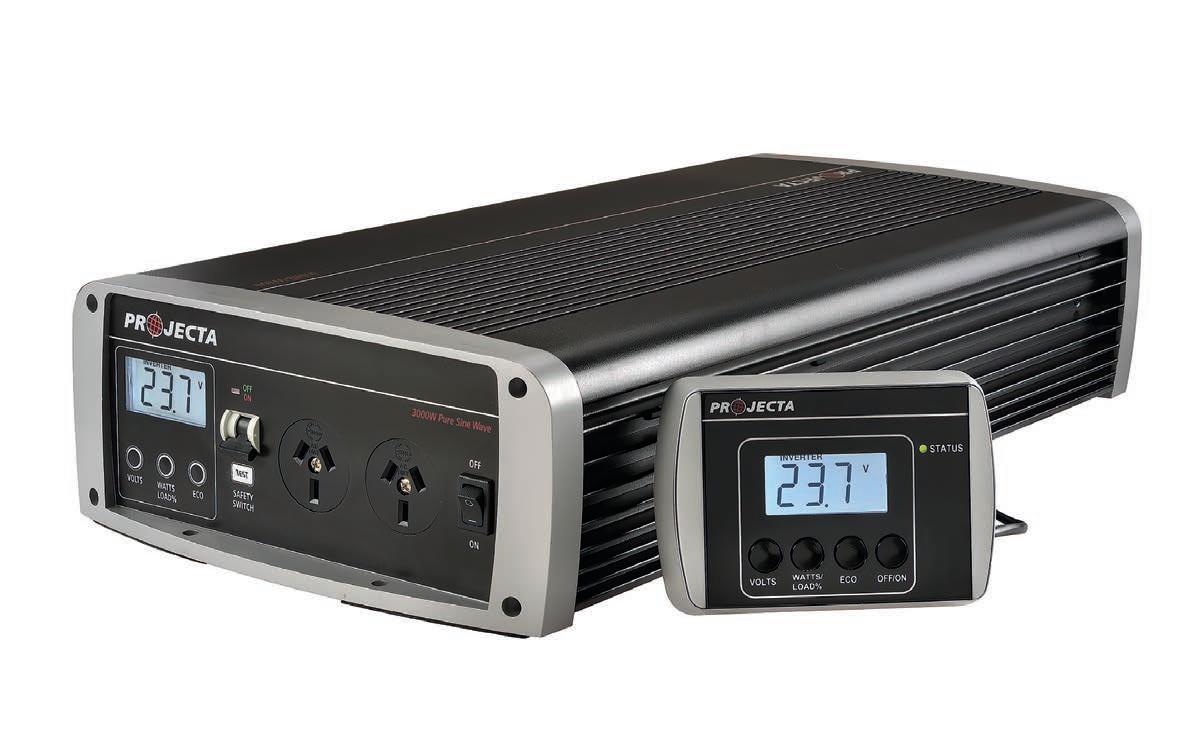
Projecta was quick to provide new technology to meet market interest.
The result is an upgraded Projecta 3000W 24V Pure Inverter that builds on the previous 12V 1500W and 3000W variants launched last year.
“With people now upgrading their buses or motorhomes to feature induction cooktops and air-conditioning, this new inverter model caters to this demand,” Projecta Technical Support Officer Ben Blood told ABC.
“It’s providing buyers with an even greater choice for their application and vehicle type.”

The new model delivers 3000W of ultra-clean power to run a wide range of low draw and power-demanding equipment including air compressors, large power tools, induction cooktops and air-conditioning.
With an LCD display that can provide voltage and power usage information, the Projecta model comes with a built-in safety switch alongside voltage,
temperature (up to 65 degrees Celsius), fault and overload protections. Yet Blood says the best feature of the newest member of the INTELLI-Wave 24V Inverter range is its surge power capabilities.
“The model is able to provide surge power for three seconds,” Blood says. “This is enough ‘kick’ to switch on many common appliances that require more power to start than they do to run.
“Our competitors only offer a maximum of one second surge power, while ours ensures that it can run what our customers want to run.”
Alongside this update, the increase in safety is a major feature on the new Projecta Pure Inverter. The inbuilt safety switch provides more protection for the user and the connected devices while eliminating the labour time of wiring and installing an external safety switch.
The updated model fills a market gap of higher surge power induction for high-powered appliances such as
air compressors, air conditioners and heavy duty motors. With an in-built AC unit included, Projecta can also offer seamless switching between AC and DC power sources in milliseconds without needing appliances to be turned off.
Projecta, a brand under Brown and Watson International (BWI), is looking to expand its power management catalogue that includes its growing range of inverters and chargers.
Although the inverter is designed for trucks and other large equipment that run 24V electrical systems, Blood says it is ideal for buses and motorhomes. A hardwiring AC output solution on the back of the inverter makes it easier for operators and motorhome owners to have multiple outlets around the bus and be confident that the inverter can power demanding appliances.
“Lots of new appliances are requiring more power, especially when they go gasless,” Blood says. “Motorhome buses generally have more space and cater for a full-size fridge, a two-to-four burner induction cooktop and an air compressor alongside water pumps, electric power tools for campsites and lots of lighting.
“All of these loads combined need a lot of power from the inverter when off-grid.”
For those looking to convert buses into motorhomes, the new 3000W version of the Projecta Pure Inverter allows for future expansion if they later want to add more appliances. Blood recommends motorhome owners to future-proof their vehicles by accommodating for more power in the long run via a larger inverter.
From Blood’s perspective, planning where high-power appliances will be located is a key step to getting the most out of the inverter, as owners can then design the power management system around the appliance location.
“It’s best to have the inverter as close as possible to the battery,” he says.
The inverter also works on
electric buses, with only one catch. Blood says if an electric bus can output the current (Amps) required then it will work with the inverter. However, he does note that continuous usage of high-power appliances will quickly lower the battery’s life.
This is why the Projecta Pure Inverter’s ECO mode is so important for the bus industry. When no load is detected, the inverter can draw just the 10mA of current during standby mode, meaning power can be saved to just 0.24Ah drawn per day.
If there was no ECO mode, an inverter on standby mode would usually draw 1A of current, equating to 24Ah for the day without use.
“This feature will save batteries dramatically and keep customers off the grid for longer,” Blood says.
The latest update in the INTELLI-Wave Inverter range from Projecta is also designed to be tucked away for convenience.

With a remote connected, bus owners can monitor all parts of the inverter and turn it on and off remotely.
The model, which is made from extruded aluminium to be dust-proof and shock-resistant, is an update that Projecta is proud to show off to the bus and coach industry.
“The ECO mode can reduce current draw by a factor of 100, meaning battery charge can last for more than 300 days compared to only seven to 10 days without ECO mode,” Blood says.
“It’s backed by a five-year warranty and we’re proud of the latest addition in a long line of INTELLI-Wave products.”
The ECO mode can reduce current draw by a factor of 100, meaning battery charge can last for more than 300 days compared to only seven to 10 days without ECO mode.
welcome it.”
Alongside this diverse perspective, Brown welcomed consultations on training pathways after the federal government announced 480,000 fee-free TAFE places to get people in the industry.
Brown then discussed climate change and the National Electric Vehicle Strategy that the federal government is pushing to encourage the zero-emissions transition.
“We’re also looking at the role that biofuels can play in the decarbonisation of the heavy vehicle industry,” Brown says.
“We’ll continue looking at funding hydrogen hubs, such as the Hydrogen Highway between Melbourne and Sydney proposed by Viva Energy, to reduce the cost of procuring green hydrogen.”
Brown finished by saying she’s escalating the development of two new Australian Design Rules (ADRs) to regulate electric and hydrogen fuel-cell heavy vehicle technology, including for buses and coaches.
TSummit, courtesy of the Bus Industry Confederation (BIC), once again returned to Canberra’s Hotel Realm in March, allowing the industry to discuss a wide range of issues pertaining to its future.

BIC Chair Tony Hopkins opened the Summit before handing to Senator and federal assistant transport and infrastructure minister Carol Brown to give the opening address.
After presenting at last year’s BIC National Conference in November, Brown says the industry has made good use of the months since the conference in Brisbane, but there are more areas that she was pleased to see covered at the 2023 Bus Industry Summit.
“The industry definitely needs to attract more women, so I’m pleased to see the Women in the Bus Industry panel that will run,” Brown says.
“It’s a timely introduction and I warmly
In the opening session, consultant Ken Kanofski also presented details and findings on the Heavy Vehicle National Law (HVNL) reform.
After the Infrastructure and Transport Ministerial Meeting (ITMM) first commissioned the report from Kanofski in February 2022, Kanofski has since led a package of propositions to update the HVNL.
He says seven themes were part of the changes, including access and fatigue.
“In some ways, the reforms don’t go as far as I would’ve liked them to,” Kanofski says.
Kanofski says the recently created HVNL Steering Committee will ensure consistent enforcement of these findings and proposals for the future of the bus and coach industry.
Following the opening session, the theme of a green future was quickly put into action on the Future Buses panel, chaired by BIC Councillor Rolf Mitchell.
The panel, containing Rahila David from the Centre for Connected and Automated Transport (CCAT), first looked at the state
WORDS & IMAGES SEAN MORTELL
A jam-packed 2023 edition of the Bus Industry Summit saw some new points raised to evolve the future of the bus and coach industry, as well as touching on crucial supply chain and skilled worker challenges.
of automated vehicles and how they fit into the industry.
David says the potential benefits of automated vehicles include increased safety, efficiency, sustainability, access, mobility, reduced carbon emissions and an improved economy and society.
John Anasis from the Commonwealth Bank Australia also discussed how banks such as CBA can help finance and loan zero-emissions buses for owners.
“The total cost of ownership is the biggest driver of the EV transition, more so than the carbon agenda,” Anasis says.
The afternoon panels looked at new social contracts and both recruiting and retaining diverse workers in the industry.
While Keolis Downer’s James Edmiston looked at modern slavery in Australia, Christine Atkins gave tips on how to fulfil local content requirements after her experience in the rail industry as a director at NineSquared.
CDC Australia CEO Nicolas Yap discussed the major operator’s Reconciliation Action Plan (RAP) in the past year, while Sharon Stevenson from Transdev Australasia gave insights into the operator’s own RAP journey and respecting all cultures in Australia.
The final session of the day looked at women in the bus industry, with a full panel of women discussing the current challenges facing women in the sector.
But the panel evolved to hold wider talks on how to make the bus industry more attractive for younger generations and other pools of potential workers, as well as strategies to better retain employees.
While the collective of women on the panel agreed that the industry has been welcoming to them, they said that encouraging both men and women to be role models for new workers will help lure and keep more important workers from diverse backgrounds.
“I share all of the sentiments of these women up here with me at the conference,” Volvo Bus Australia’s Sarah Forbes says.
“The work our industry does is
With the NHVR planning to transition services in Queensland by the end of the year, the NHVR is also working on the future of heavy vehicles and Performance Based Standards (PBS) reforms.
“The Future Heavy Vehicles regulatory process is about the regulator supporting the industry in the future of this technology,” Austin says.
This gave way to one of the highlights of the Summit in a full panel consisting of members from Mondo New Energy, Hitachi Zero Carbon, JetCharge, Optibus, EnergyAustralia, Evenergi and TigerSpider that looked at planning and operating strategies to get the most out of zero-emissions buses.

The majority of questions were directed at EnergyAustralia’s Jack Kotlyar about the availability of energy moving forward to power
industry.
“We don’t have an issue with having not enough energy, we have an issue when it becomes zero-emissions that it will cost way too much,” he says.
While the National Technical Seminar closed with a review of 2022, the National Industrial Relations and Workforce Seminar spent the day looking at government IR reforms, sexual harassment in the workplace and improving the image of the bus and coach industry, before finishing with further discussions on recruitment and retention initiatives.
From new topics like women in the bus industry and modern slavery, alongside common themes such as zero-emissions buses and staff retention, the 2023 edition of the BIC Summit forged new ground in tackling industry challenges.



In just its second month, it’s clear ABC Magazine’s Best Bus photo competition is going to new heights, with more than 120 entrants sending in their best photos of their bus or coach.
This wide selection made it incredibly hard to select a winner, with many finalists submitting beautiful photos. ABC has loved receiving all of these photos and look forward to receiving more photos from all of you each and every month!
The winner of the monthly competition will have their photo shown off on the ABC Facebook cover photo slot for the entire month, while the entrant with the most beautiful bus photo will also receive a free 12-month subscription to ABC Magazine.
When it comes to honourable mentions, Daniel Clarke came very close to winning with his wonderful
photo of a Clarke’s bus on a green and grassy hill – we certainly look forward to seeing more photos from him each month.
Ivan Sutrisno’s photo of a Grayline Tours bus at sunset was also brilliant, while Nem Dodd’s Dubbo Buslines and John Austin’s shot of a colourful Kinetic caught our eye. A special mention also goes to the Dyson Group, with many eager staff sending in their favourite photos!
Our last honourable mention goes to Stephen Roos for his beautiful Irizar i6 coach.

Yet it was one photo that stood above the rest, and it came courtesy
of Sam McKee. This photo of a Volvo/ Irizar coach was made special by its sunflower surroundings, certainly living up to the Sunstate Coaches name!
Sam says the photo puts both Sunstate Coaches and the setting of Casino on the map in one hit, as the magical picture was taken on Sam’s Samsung S21 Ultra!
Flip over the page to see many of our finalists and entrants’ photos from what was an amazing month, and don’t forget to send through your Best Bus photos for the months ahead via email and keep an eye on our Facebook page for more details!
Flip over the page to see many of our finalists and entrants’ photos from what was an amazing month.This ripper from Sam McKee took out the top prize for April


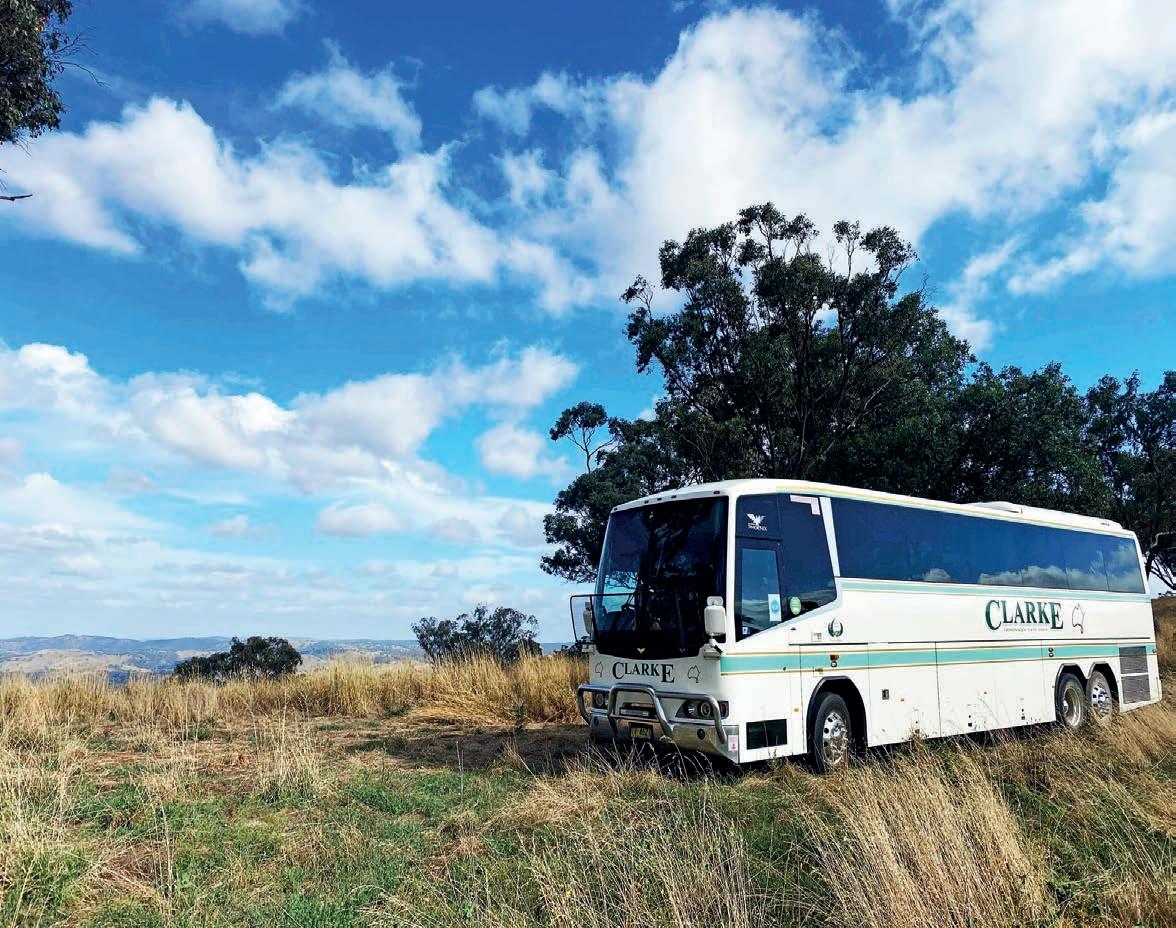


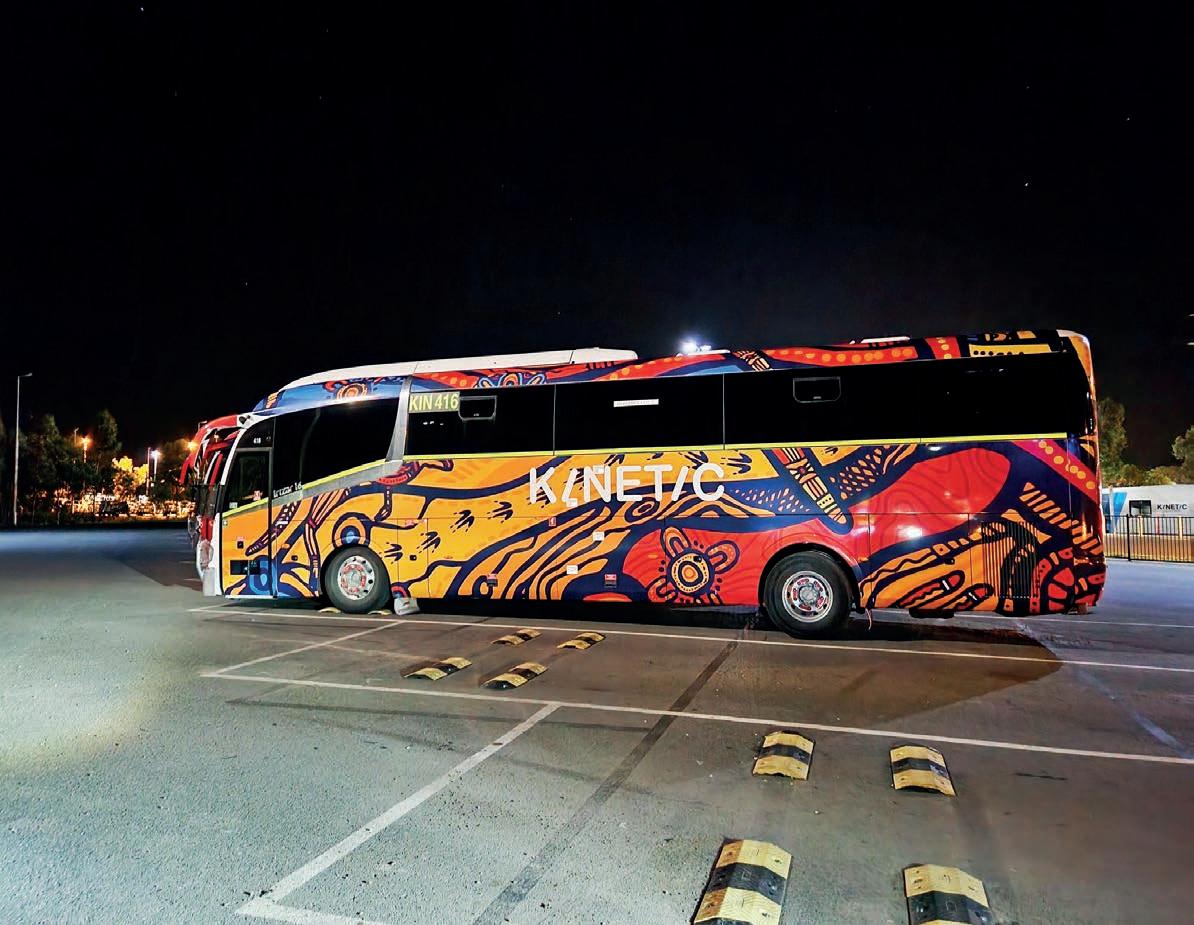



 Top, Left to Right: Another angle from Sam McKee and Daniel Clarke’s wonderful grassy shot Middle row, Left to Right: A clean Irizar i6 from Stephen Roos, Ivan Sutrisno’s shot of a Grayline Tours coach and John
Top, Left to Right: Another angle from Sam McKee and Daniel Clarke’s wonderful grassy shot Middle row, Left to Right: A clean Irizar i6 from Stephen Roos, Ivan Sutrisno’s shot of a Grayline Tours coach and John
The Australasian industry’s leading exhibition, conference and networking event will be combined all under one roof at Australia’s premier expo venue.
• 10,500m² of vehicle and equipment exhibition space and trade exhibition booths


• Technical & management conference sessions delivered within the exhibit. 1400 strong BusVic 80 year anniversary industry gala dinner on Tuesday 1st October in the Melbourne Room at Melbourne Exhibition and Convention Centre.


• Keynote speakers on both days.
To express your interest in exhibiting at the event, please visit: www. busvic.asn.au/Exhibitor-EOI

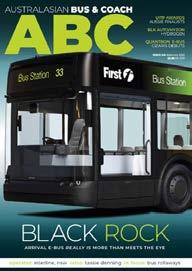
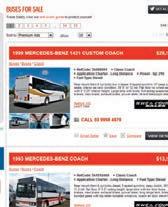



Cummins ISB300hp, Automatic inc a retarder, 57 fixed coach seats inc lap sash seat belts, A/C, underfloor bins travelled approx. travelled approx. 100,000klms $85,000+GST
ZF AsTronic trans,13.5m Irizar I6 body,52 leather reclining seats,DVD,toilet,A/C,large undefloor bins,travelled approx. 320,000klms $205,000+GST



ISB300HP
Automatic inc a retarder, 53 reclining coach seats inc lap sash seat belts, A/C, underfloor bins, school lights, Hanover destination sign, clean bus, travelled approx. 285,000klms POA
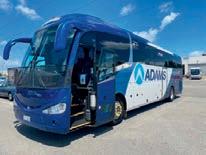




6sp manual, Quality Bus & Coach body, 28 lap sash seat belted seats, Thermo King A/C, UHF, Bull bar, travelled approx. 129,000klms $160,000+GST

Opticruise transmission including a retarder, Irizar 13.5m “Century” bodies, 54 lap sash seat belted seats, 48 when 2 wheelchairs fitted, rear toilet, A/C, plus more, travelled approx.1,5001,650,000klms, engines and transmissions have been rebuilt approx. 4-500,000klms
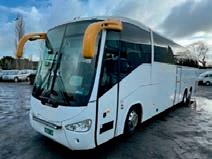






REDUCED TO $110,000 +GST each
I Shift, Wheelchair accessible, Coach Concepts 13.5m body, 52 lap sash seat belted recliners, toilet, underfloor bins, Thermo King A/C, service history, travelled approx.1,500,000klms $115,000+GST



K440EB
Wheelchair lift equipped, Opticruise, Irizar I6 13.5m body, 52 lap sash seat belted recliners, toilet, DVD many extras, travelled approx. 1,530,000klms
REDUCED TO $160,000+GST

Automatic, Cummins ISB300hp, 10,.0m, 41 lap sash seat belted seats, DVD, A/C, large underfloor bins, many extras, travelled approx. 116,000klms $165,000+GST
CUMMINS ISM410HP Allison auto inc retarder, 58 lap sash seat belted leather recliners, rear toilet, Tracs A/C, large underfloor bins, very clean, complete service history Wheelchair lift equipped Reduced to $95,000 +GST

2013 VOLVO B9R


Shift, 12.5m Irizar I6 body, 40 lap sash seat belted leather recliners, toilet, 2 door, underfloor bins, DVD with 5 monitors, plus more, travelled approx 985,000klms $130,000+GST

To advertise email matt.alexander@primecreative.com.au — Bookings for next issue close 3rd MAY 23




Be sure not to miss out on an opportunity to attend these fantastic in-person events
MAY
BusNSW
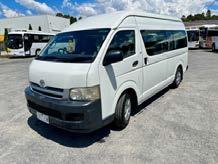
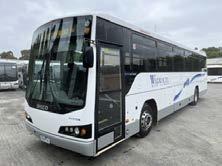
Delegates Forum/ Country & Metro/ BusNSW
AGMs/ BoM-BCIA-Coop Meetings
JUNE
QBIC
June 16
Regional Member Forum Gympie/ Maryborough

TasBus
June TBA
Annual Conference and Dinner
UITP Global Public Transport Summit (Barcelona)

June 15-17
JULY
BusVic
July 11-14
Maintenance Conference & Trade Show Melbourne

BusWA
July 13-14
Conference in Perth
AUGUST
QBIC

August 5

Regional Member Forum Chinchilla
25
Forum
September 8
Forum Cairns
ItmayhavebeenaslowerFebruaryfordeliveries,butthetemporary troughhasbeenhitoutoftheparkbyarecordMarch
Superb deliveries results in January have been replicated after a quiet February, with March’s statistics for buses and coaches delivered in Australia reaching all-time highs since the COVID-19 pandemic first hit the world.

February’s drop-off to 73 deliveries has been more than doubled in March, with 156 deliveries being recorded for the month in an amazing increase.
When it came to chassis, a perennial leader of the market flexed its muscles and returned to the top in a big way. After languishing to start the year, Volvo proved why it is such a big name in the chassis market, recording an astounding 67 units delivered in March, well ahead of the second-placed MercedesBenz (18). Scania has had a good start to the year and continued it with 17 more deliveries for March, while Yutong (13) and Denning (10) both recorded double figures for the month. Not far behind was King Long (nine) and I-Bus (seven), while BCI stayed narrowly ahead of BYD and MAN (three apiece) with the five deliveries and BLK and BusTech Group rounded out the diverse market with two units each.
Following some surprise results to start the year in the bodybuilding game, market heavyweight Volgren returned to the lead in resounding fashion in March. After Yutong took out honours to start 2023, Volgren recorded 55 deliveries for March, shooting well clear of the next best Irizar, who improved to 19 deliveries. Custom Denning also increased to 18 deliveries, while BCI (15) and Yutong (13) both had productive months. Both King Long (nine) and I-Bus (seven) remained consistent with their body sales and Supportrans (five) got its name on the board ahead of Express Coaches and Coach Concepts (three apiece). The final nine deliveries were shared between five companies in an even finish.
If Yutong’s seating dominance was a shock to
start 2023, old habits resumed with the resurgence of McConnell. The seating giant shot back up the leaderboard with an eyepopping 69 deliveries for the month, well ahead of the next best but improving Sege (27). Just behind Sege was the consistent StyleRide with 26 units, while Yutong (13) maintained its consistency ahead of King Long (nine). In a secluded market, the final deliveries were snatched up by APM (seven) and TST (five).
Thermo King returned to form in February and it exploded in March, with 58 deliveries keeping it clear on top of the airconditioning market. It more than doubled the next companies, with Hispacold (20) and Coachair (20) both recording good months to remain locked in equal second. Cling-Yutong was next with 13 deliveries, keeping just ahead of Valeo with 12. King Long (nine), Denso (eight) and Songz (seven) could all barely be separated, while Spheros (five) helped contribute as MCC (three) and Konvekta (one) rounded out the sector.
When looking at the state-based rivalry, the maroon of Queensland was replaced at the top by its State of Origin rival. New South Wales shot to prominence, recording 42 deliveries, or 27 per cent of the market. Queensland wasn’t far behind, falling to third with 37 deliveries, as Victoria stormed into second place with 39. Western Australia increased its deliveries to 30 units, or 19 per cent, while South Australia (four), Tasmania (three) and the ACT (one) all remained on the board in a busy March.
Turn overleaf for comprehensive bus and coach delivery information for March. Please note all data is as supplied from manufacturers, at their discretion.
Following some surprise results to start the year in the bodybuilding game, market heavyweight Volgren returned to the lead in resounding fashion in March.
IfYutong’sseatingdominancewasa shocktostart2023,oldhabitsresumedwith theresurgenceofMcConnell.Theseating giantshotbackuptheleaderboardwithan eye-popping69deliveriesforthemonth, wellaheadofthenextbestbutimproving Sege(27).JustbehindSegewasthe consistentStyleRidewith26units,while Yutong(13)maintaineditsconsistency aheadofKingLong(nine).Inasecluded market,thefinaldeliveriesweresnatched upbyAPM(seven)andTST(five).
Following some surprise results to start the year in the bodybuilding game, market heavyweight Volgren returned to the lead in resounding fashion in March. After Yutong took out honours to start 2023, Volgren recorded 55 deliveries for March, shooting well clear of the next best Irizar, who improved to 19 deliveries. Custom Denning also improved to 18 deliveries, while BCI (15) and Yutong (13) both had productive months. Both King Long (nine) and I-Bus (seven) remained consistent with their body sales and Supportrans (five) got its name on the board ahead of Express Coaches and Coach Concepts (three apiece). The final nine deliveries were shared between five companies in an even finish.
Thermo King returned to form in February and it exploded in March, with 58 deliveries keeping it clear on top of the air-conditioning market. It more than doubled the next companies, with Hispacold (20) and Coachair (20) both recording good months to remain locked in equal second. Cling-Yutong was next with 13 deliveries, keeping just ahead of Valeo with 12. King Long (nine), Denso (eight) and Songz (seven) could all barely be separated, while Spheros (five) helped contribute as MCC (three) and Konvekta (one) rounded out the sector.
When it came to chassis, a perennial leader of the market flexed its muscles and returned to the top in a big way. After languishing to start the year, Volvo proved why it is such a big name in the chassis market, recording an astounding 67 units delivered in March, well ahead of the second-placed Mercedes-Benz (18). Scania has had a good start to the year and continued it with 17 more deliveries for March, while Yutong (13) and Denning (10) both recorded double figures for the month. Not far behind was King Long (nine) and I-Bus (seven), while BCI stayed narrowly ahead of BYD and MAN (three apiece) with the five deliveries and BLK and BusTech Group rounded out the diverse market with two units each.
N/AWA1KingLongKingLong360REuro5
MAN EmersonBusCompanyQLD1MANIC.19.320.RR8Irizar320REuro5
NovaCoachNSW2MANIC.19.360.RR8Marcopolo360REuro6 MERCEDES-BENZ N/ANSW1OC500RFE61930Custom300REuro6
N/AVIC1OC500RFE51936Irizar360REuro5
N/AVIC1OC500RFE51936BCI360REuro5
N/AQLD3OC500LEE6Volgren300REuro6
N/AVIC1OC500RFE51936Irizar360REuro5
N/ANSW4OC500LEE6Custom300REuro6
N/AVIC1O500RSIrizar360REuro6
N/AVIC1O500RSIrizar360REuro6
N/AVIC2OC500RFE51936BCI360REuro5
N/AQLD2OC500RFE51936BCI360REuro5
N/ANSW1O500RCustom300REuro5
SCANIA B&GChristianVIC1K320CB4x2NBCoachDesign320REuro6
B&GChristianVIC1K370CB4x2NBScaniaHiger370REuro6
CranbourneTransitVIC1K320CB4x2LBVolgren320REuro6
CranbourneTransitVIC1K320CB4x2LBVolgren320REuro6
GillicksBuslinesVIC1K370CB4x2NBIrizar370REuro6OpticruiseScania212.5Hispacold –
Gosel'sBusCompanyNSW1K310IB4X2ExpressCoaches310REuro5
IrizarAsiaPacificQLD1K360IB4X2IrizarN/AREuro5OpticruiseScania2
JasperBrosBusCompanyVIC1K310IB4X2ExpressCoaches310REuro5OpticruiseScania212.5Hispacold
KineticMelbourneVIC1K320HB4x2LBVolgren320REuro6OpticruiseScania212.5Thermo
LCDyson'sBusServicesVIC1K320IB4X2Irizar320REuro6
LCDyson'sBusServicesVIC1K320IB4X2Irizar320REuro6
MurraysCoachesQLD5K320CB4x2NBBCIN/AREuro6OpticruiseScania2
StMarysSecondaryCollegeVIC1K310IB4X2ScaniaHiger310REuro5OpticruiseScania2
VOLVO
PublicTransportAuthorityWAWA26VolvoB8RLEVolgren320REuro6
MacquarieEducationalToursNSW1VolvoB11RIrizar450REuro5
MtGravattBusServiceQLD1VolvoB8RLEVolgren320REuro6
IrizarAsiaPacificQLD4VolvoB8RIrizar330REuro5
ChristensensBus&CoachQLD1VolvoB8RVolgren330REuro5
IrizarAsiaPacificQLD1VolvoB8RIrizar330REuro5
RiversideChristianCollegeQLD1VolvoB8RIrizar320REuro6
HunterValleyBusNSW1VolvoB8RVolgren320REuro6
HunterValleyBusNSW5VolvoB8RLEVolgren320REuro6
TransdevQueenslandQLD5VolvoBZLElectricVolgrenN/AN/AZero
HornibrookBusLinesQLD1VolvoBZLElectricVolgrenN/AN/AZero
WBLPtyLtdVIC4VolvoB8RSupportrans330REuro5
NulineCharterVIC1VolvoB11RCoachConcept410REuro5ASVolvo210-12.9Spheros –
SunburyCoachesVIC1VolvoB11RIrizar460REuro6ASVolvo313-14.9Hispacold –
WillungaCharterSA1VolvoB8RSupportrans330REuro5
LatrobeValleyBuslinesVIC2VolvoB8RCoachConcept350REuro6ASVolvo210-12.9Spheros –50 –X – – – –StyleRideY
SimcocksVIC2VolvoB8RIrizar330REuro5
BuswaysNSW2VolvoB8RCustomDenning330REuro5
RegOsbornPtyLtdNSW1VolvoB8RExpress330REuro5
HunterValleyBusNSW4VolvoB8RVolgren320REuro6AS TransdevQueenslandQLD1VolvoBZLElectricVolgrenN/AN/AZero
CDCSouthEastQLDQLD1VolvoB8RLEVolgren320REuro6
YUTONG
N/ANSW7YutongD12Yutong360REuro5
N/AQLD1YutongD12Yutong360REuro5
N/AVIC2YutongD12Yutong360REuro5
N/AWA1YutongD7Yutong190FEuro6
N/AQLD1YutongD7Yutong190FEuro6
N/ANSW1YutongD7Yutong190FEuro6
AZF212.3MCC –53 – –X – – –SegeYN AAllison212.3ThermoKing57 – – –X – – –McConnellYN AN/A212.3Coachair57 – – –X – – –SegeYN AZF212.3MCC57 – – –X – – –SegeYN AAllison212.3MCC –55 – –X – – –SegeYN AZF213.2Valeo65 – – – – –X –SegeYN ABYD212.1ThermoKing – –37 – –X – –McConnellNY AZF210-12.9ThermoKing48 – – – –X – –StyleRide/McConnellNY AAllison212.5Valeo57 – – – – –X –StyleRideYN N/AN/A212.5Valeo – –43 – –X – –McConnellNY 5ASIsuzu28Songz32 – – – – –X –APMYN 5ASIsuzu28Songz32 – – – – –X –APMYN 5ASIsuzu28Songz32 – – – – –X –APMYN 5ASIsuzu28Songz32 – – – – –X –APMYN 5ASIsuzu28Songz32 – – – –X – –APMYN AZF212KingLong57 – – – – –X –KingLongYN AZF29KingLong40 – – –X – – –KingLongYN AZF212KingLong57 – – –X – – –KingLongYN AZF212KingLong57 – – –X – – –KingLongYN AZF29KingLong40 – – – – –X –KingLongYN AZF212KingLong57 – – – – –X –KingLongYN AZF212KingLong57 – – –X – – –KingLongYN AZF212KingLong57 – – –X – – –KingLongYN AZF212KingLong57 – – –X – – –KingLongYN AZF212.5Hispacold57 – – – – –X –SegeYN AZF212.3Spheros –53 – –X – – –SegeYN AZF212.5ThermoKing57 – – – – –X –StyleRideYN AZFEcolife212.3Hispacold57 – – – – –X –McConnellYN AZFEcolife212.3ThermoKing57 – – – – –X –SegeYN AZF212.5Coachair – –43 – –X – –StyleRideNN AZFEcolife212.3Hispacold57 – – – – –X –McConnellYN AZF212.5ThermoKing – –45 – – –X –McConnellNN AZF212.3Hispacold57 – – – – –X –SegeYN AZF212.3Hispacold57 – – – – –X –SegeYN AZFEcolife212.3ThermoKing57 – – – – –X –McConnellYN AZFEcolife212.3ThermoKing –53 – – –X – –SegeNN AZFEcolife212.3ThermoKing43 – – – – –X –StyleRideYN AZF212.5ThermoKing57 – – – – –X –StylerideYY AZF212.5Denso58 – – – – –X –StylerideYN AZF212.5ThermoKing – –44 – –X – –McConnellNN AZF212.5ThermoKing – –44 – –X – –McConnellNN 6OpticruiseScania212.5Hispacold –48 – – – –X –SegeYN AZF212.3ThermoKing57 – – – – –X –McConnellYN 5OpticruiseScania212.3Hispacold57 – – – – –X –SegeYN 5OpticruiseScania212.5Hispacold57 – – – – –X –StylerideYN 6OpticruiseScania212.5ThermoKing – –43 – –X –McConnellNN AZF212.5Hispacold –48 – – – –X –SegeYY AZF212.5Hispacold –48 – – – –X –SegeYY 6OpticruiseScania212.3ThermoKing –45 – – – –X –TSTYN 5OpticruiseScania212.3Konvekta58 – – – –X –SegeYN AZF210-12.9ThermoKing – –41 – –X – –McConnellNY ASVolvo310-12.9Hispacold –56 –X – – – –SegeYY AZF210-12.9ThermoKing – –44 – –X – –StyleRideNY AZF210-12.9Hispacold –53 – –X – – –SegeYN AZF210-12.9ThermoKing65 – – – – –X –McConnellYN AZF210-12.9Hispacold57 – – – – –X –SegeYN AZF210-12.9Hispacold45 – – – – –X –SegeYN AZF210-12.9Coachair53 – – – – –X –McConnellYN AZF210-12.9Coachair – –35 – –X – –McConnellNY ASVolvo210-12.9Denso – –44 – –X – –StyleRideNY ASVolvo210-12.9Denso – –44 – –X – –McConnellNY AZF210-12.9Coachair57 – – –X – – –McConnellYN 5ASVolvo210-12.9Spheros –48 – –X – – –StyleRideYN 6ASVolvo313-14.9Hispacold –52 – –X – – –SegeYN AZF210-12.9ThermoKing57 – – –X – – –StyleRideYN 6ASVolvo210-12.9Spheros –50 –X – – – –StyleRideYY AZF210-12.9Hispacold57 – – –X – – –StyleRideYN AZF212.5ThermoKing – –56 – – –X –StyleRideYN AZF212.5Coachair – –57 – – –X –StyleRideYN 6ASZF212.5Coachair53 – – – – –X –McConnellYN ASVolvo212.5Denso – –44 – –X – –StyleRideNY AZF212.5Coachair – –48 – –X – –McConnellNY AAllison212.4Cling-Yutong57 – – –X – – –YutongYN AAllison212.4Cling-Yutong57 – – –X – – –YutongYN AAllison212.4Cling-Yutong57 – – –X – – –YutongYN AAllison28Cling-Yutong27 – – – – –X –YutongYN AAllison28Cling-Yutong27 – – – – –X –YutongYN AAllison28Cling-Yutong27 – – – – –X –YutongYN
Willoughby resident Ken Wilson remembers when his town viewed its public transport network as a shining light.
“We once had the best bus service in the world,” Wilson told ABC.
“In 1992, when they added a bus lane to the Sydney Harbour Bridge, it was a complete public transport boom.”
Unfortunately, things changed in 2021 when the NSW government elected to privatise the remaining 75 per cent of Sydney’s buses. Wilson says new residential projects and planning that tried to address growing population density with more toll roads were in vain as public transport descended into chaos.
When Wilson’s local 272 bus route was cancelled, he hatched a plan to raise awareness of the situation.

“In Willoughby, we started seeing the old Channel 9 TV tower replaced with 460 apartments, many without car parking,” Wilson says. “Between a traffic report recommending new residents use one of four local bus routes and a later approval for the apartment block, all those services were cancelled.”
Wilson acted against the chaos, writing to local ministers and Transport for NSW. He was dismayed at the lack of action, as well as the cancellation of so many popular bus routes that left many Sydney-siders stranded in horrific traffic.
It was then that he launched the mutiny
after BBC announced it was against rock’n’roll music. When people were unable to set up radio stations to play rock’n’roll and rebel against BBC’s stance, they got a ship.
Wilson’s version of this was his own private bus that soon arrived to pick people up and take a stance against the government’s bus service cutting.
“We kept asking for bus services to come back and only received pushback from our local member,” Wilson says. “They must’ve known about my plans, because on the day I ran the bus, buses came from everywhere to pick up people before they could get on ours.”
It didn’t stop the mutiny bus from having an impact. Despite these tactics, Wilson’s bus had plenty of passengers onboard, some dressed in pirate clothing. From what Wilson knows, it made quite a splash at NSW’s Government House.
The mutiny bus soon gained more attention and crowdsourced money kept rolling in, fuelling Wilson’s idea to run a second service. After hiring another bus, Wilson ran a private 340 service earlier this year that went down to Bondi Beach and back.
In the lead-up to last month’s NSW state election, Wilson’s mutiny bus manoeuvres caught the eye of now
NSW Premier Chris Minns, who tried to clear his schedule to hop onboard.
With local Teal independents joining Wilson’s fight for more buses, the bus services have become a major part of NSW’s push for more bus services to be returned.

Yet Wilson’s efforts aren’t yet finished. The head pirate of the mutiny bus is now seeing which other private services he can run on his own with crowdfunding to make the burden of catching public transport around Sydney a little bit easier for everyone else.
“Following the election, the mutiny bus is now in limbo as I consider my next move,” Wilson says. “I’m interested in helping the netball association who have also lost services to their 20-court facility here in Willoughby. I’m wondering if I can run shuttles from local transport hubs – I’m open to help from anyone in the bus industry.
“The services in Willoughby are now a little better because of our stance, but I want to help get the message across that the entire state’s bus network needs to be changed to help the people out as I fear that they have just taken services away from other commuters to keep us quiet.”
In the lead-up to the recent NSW state election, Ken Wilson came up with a devious plan to lead the charge to restore bus services around Sydney





















































IP3000 & IP3000-24V2

Producing ultra-clean power which replicates household mains, Intelli-Wave inverters are ideal for the most sensitive electrical equipment.
Our largest inverters, available in 12 or 24 volt models, the IP3000 will power the most demanding 240V appliances, including air conditioners, induction cook-tops, toasters and kettles.
• 200% (6000W) startup power for the first 3 seconds
• 140% (4200W) for 3 minutes of runtime
• Uninterrupted AC transfer switch
• Eco mode extends battery runtime
• Built-in RCD safety ‘cut-out’ switch
• Flush or surface mount remote control